Barklice 2019-2020
Nymph to Adult
Martha O'Kennon
Over the past few years, I've become fascinated with the tiny creatures, almost invisible to the eye, called Barklice. They frequent my workshop's blue steel siding most months of the year, with the exception of January and February in South Central Lower Michigan. Finally in 2018, with the purchase of a new camera with a nice Macro lens, I started to get pictures of not only the adult barklouse, but also their really nearly invisible nymphs. Here's a sample of the ones I've documented.
One of the first ones I found possible to distinguish in its adult form with the naked eye is Graphopsocus cruciatus. This is a very attractive insect and probably one of the commonest barklice. On October 12 and 24 I found two females with clutches of eggs.
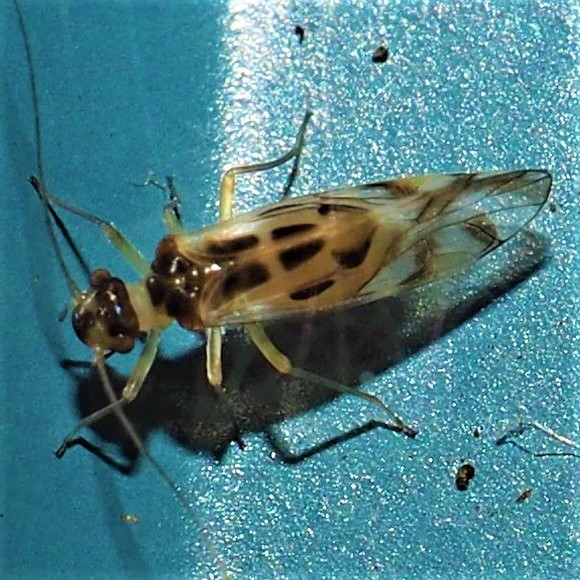
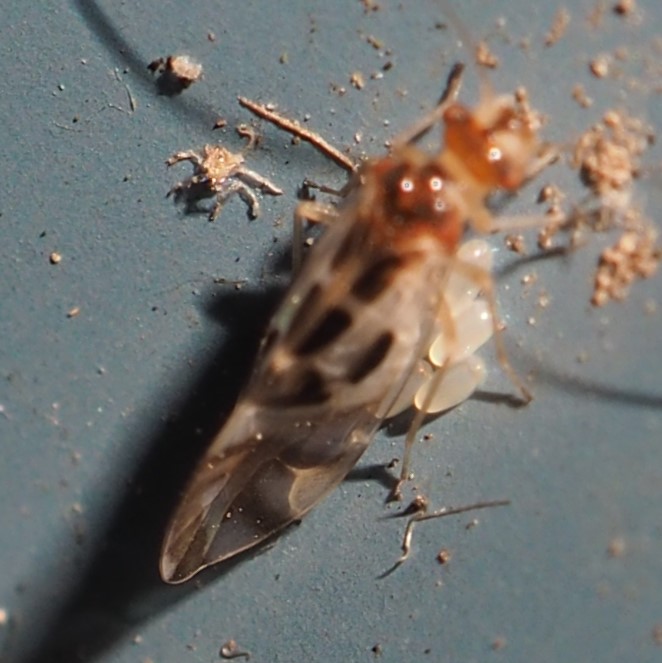
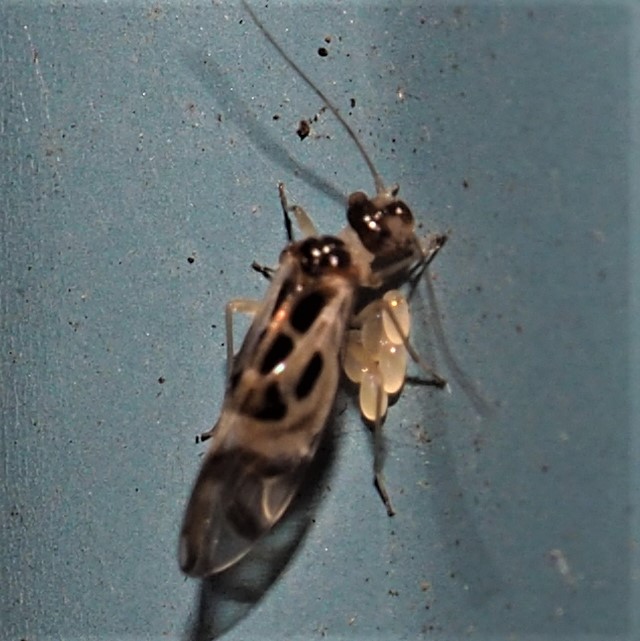
One photo that got me started thinking I understood the relationship between adult and nymph was this photo taken in October 2019. On the left is a nymph and on the right an adult Graphopsocus cruciatus. For the longest time I was trapped with the idea that a nymph will actually sidle up to its adult form.
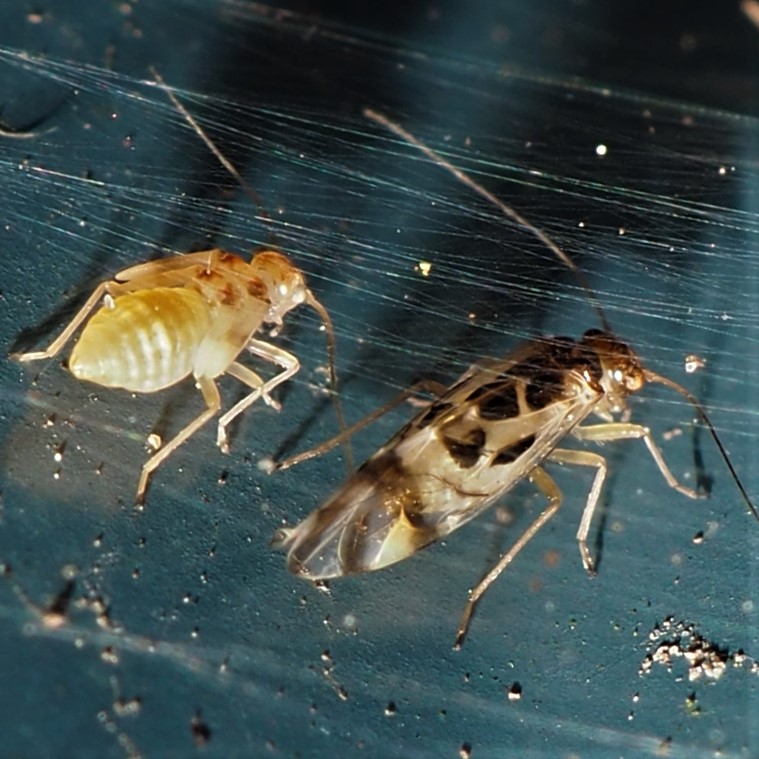
In the first week of October, 2019, we had begun to see these older nymphs (based on their wing-length). I still wonder if the difference in the abdomial color is related to sex. Both of the nymphs in picture 1 already have little wing buds. Some nymphs don't have the thoracic spots and may be those of Valenzuela flavidus, which show up as adults about the same time as G. cruciatus. On the other hand, one of the things I want to find out is whether the spots can develop with age. Third looks more like G. cruciatus. Both of these last are of a more advanced instar, as you can see from the wing length. I think we are following at least two batches of nymphs. I'm not sure when the eggs from the former row of pictures hatched and started their cycle. All of these nymphs were born before the eggs above were laid. April 2021: in hindsight, ALL of these look like G. cruciatus!
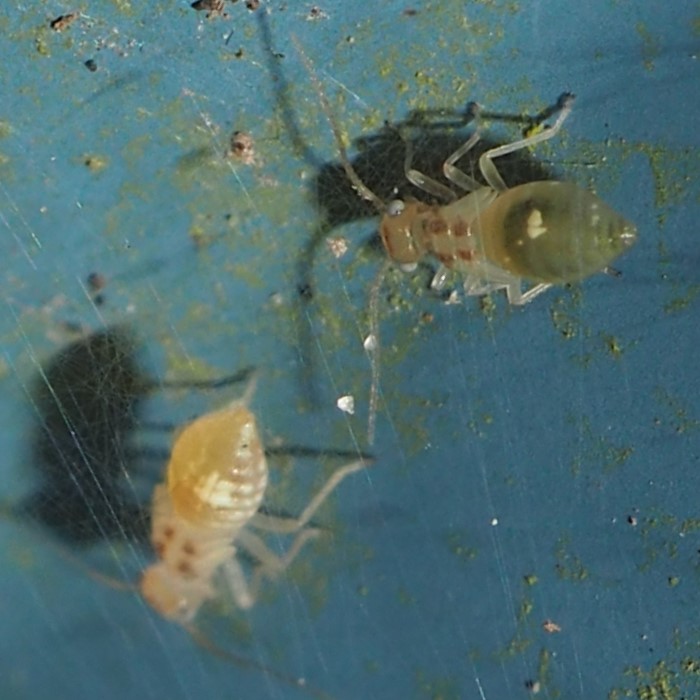
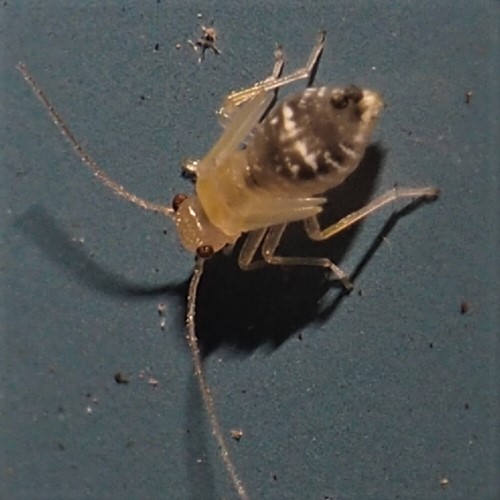
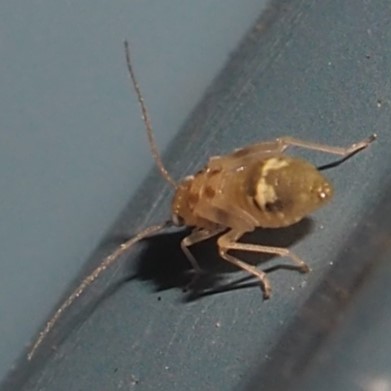
Picture 1 shows two nymphs on October 9. Note that one has longer wings than the other. One of them has just emerged from the strange skin that always appears when a new nymph shows up. In picture 2, we see a nymph emerging from one of these skins. And in picture 3, I THINK what we are seeing is an adult emerging from what will be left as one of those skins.
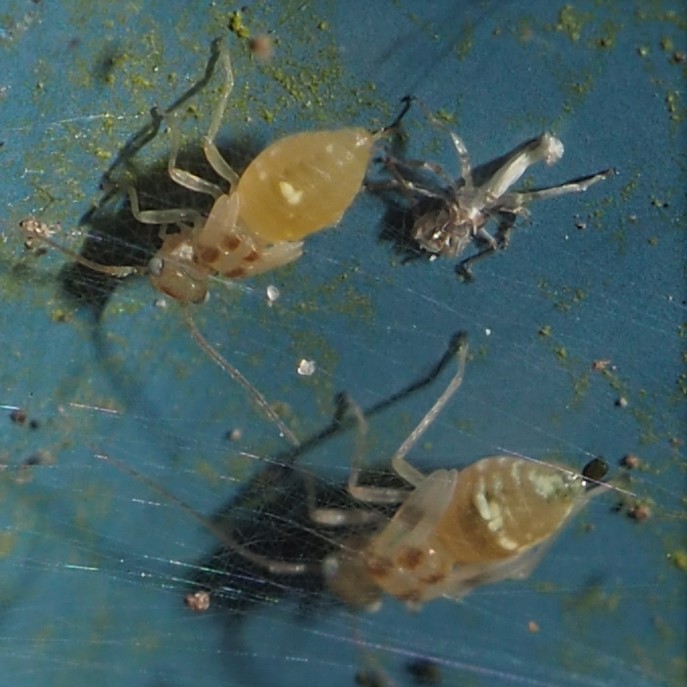
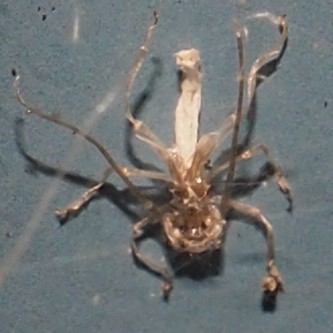
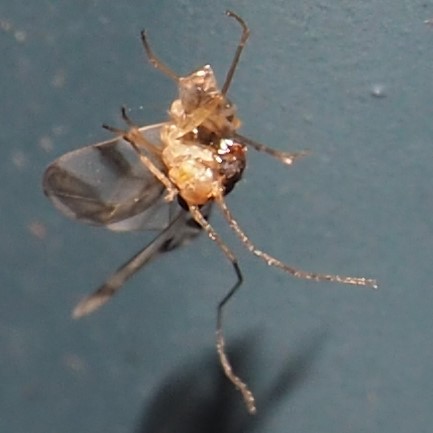
In pictures 1 and 2, taken on October 23 and 29, resp., we see a couple of somewhat older nymphs - their wings are longer and wider - They will be adults in not too much longer. 2021 - in retrospect, they are G. cruciatus!
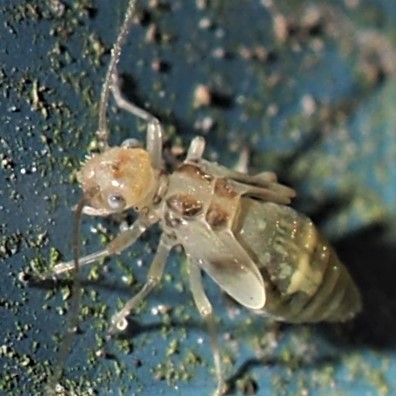
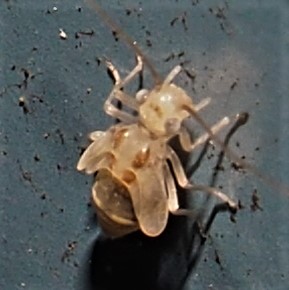
2020
I REALLY wanted to see if we couldn't begin on another batch in 2020. I saw NOTHING to think was a Barklouse adult or nymph until April 2, when a picture of a leafhopper (Erythridula abolla) was seen on cropping to harbor a really tiny barklouse nymph. It didn't have any wing development, so I'm figuring that it is one of the earliest forms the nymphs take. So I started really looking for other signs of nymph life but didn't see anything until a very strange configuration appeared (above my eyesight, so the pictures are less than optimal) on February 11. Picture 3 shows that strange scene, what looked like an ant's rear end protruding from some kind of straw-like web and just outside that "web", one nymph on the left and what looks like another on the bottom of the picture. Could this be some kind of nest?
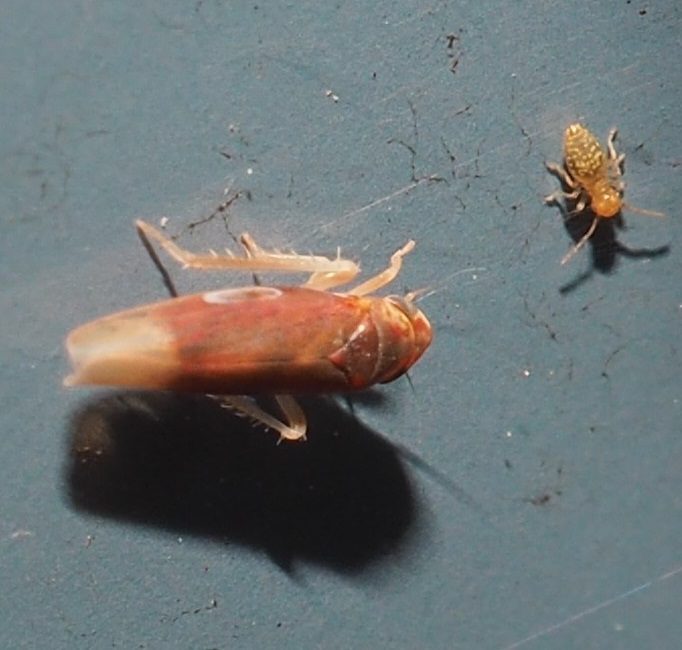
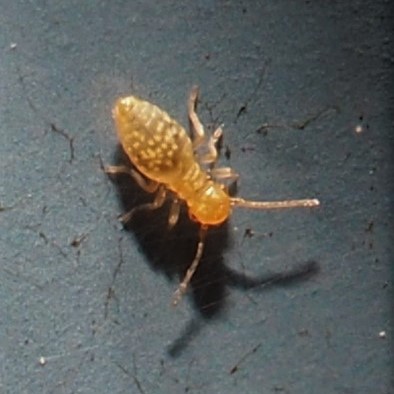

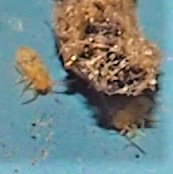
No more sightings until May 4 and 6, 2020, when I spotted one and then two nymphs near what looked like a pile of hatched eggs. Later, on May 7, I was able to locate that view, which was at about the same relative height and appeared like a tiny film of whitish dust to my view. On the screen it turned out to look very much like a field of hatched eggs.

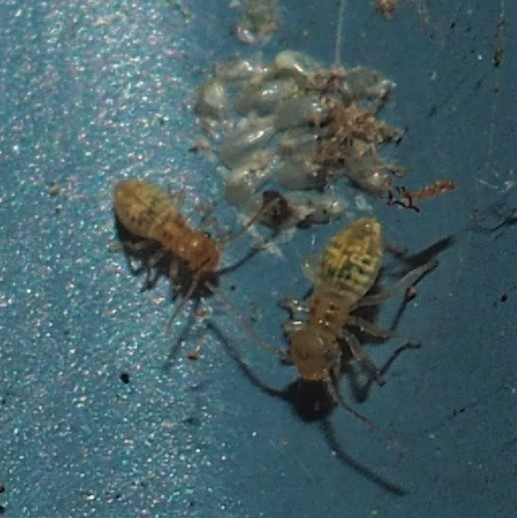
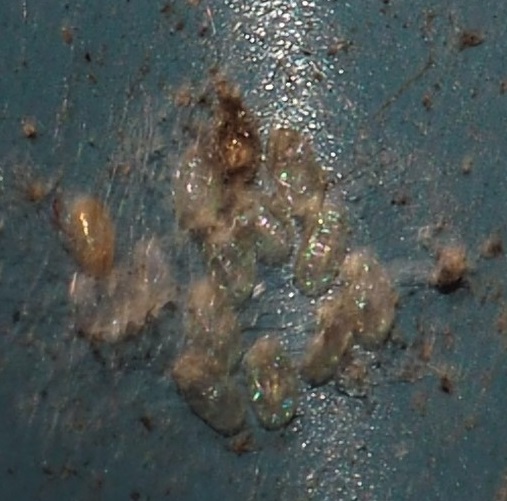
The nymphs on that east wall have steadily grown. Picture 1 shows one on May 4 with the skin it has abandoned. Pictures 2 and 3 show two nymphs each on May 11. In each picture, one clearly is advanced a bit since it has little wing buds. If the other has any wing buds, they are certainly minimal!
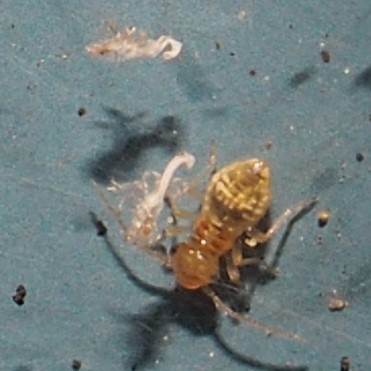
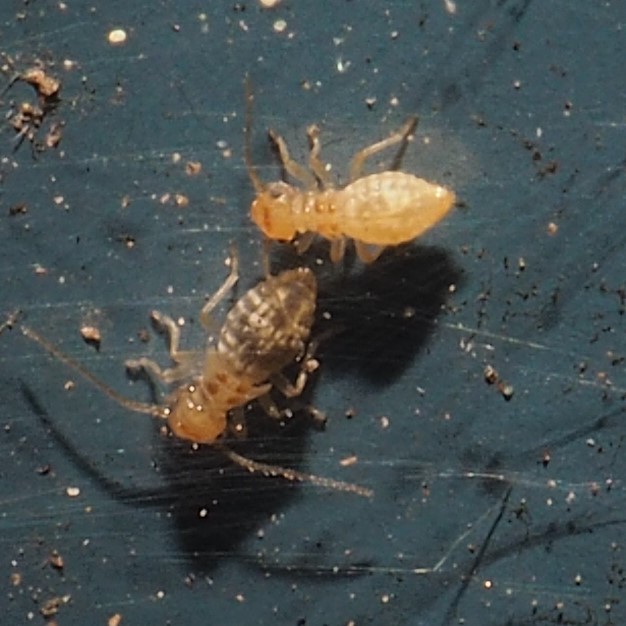
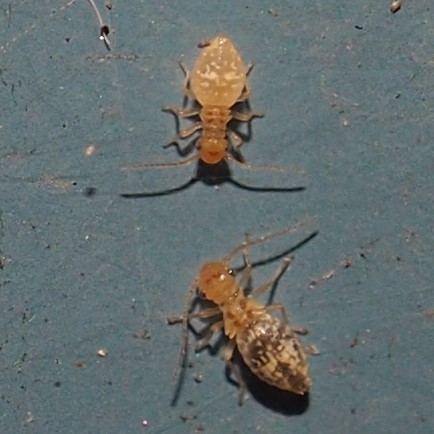
Last year (2019) I'd seen quite a lot of barklouse nymphs and adults on the North side of the Shop, especially on the closest panel to the
east corner. But this year I've been looking since the ones on the East side started up, and seeing nothing. The ones on the East side were getting easier to see as they grew longer, but there were NO easy-to-see ones on the North side, even on panel 1. But on May 17, my close looking paid off. Suddenly a little bunch of tiny dots just "looked right", even though they didn't look like the ones on the East face. All of a sudden a hunch paid off and some really tiny nymphs appeared in the picture. But then I couldn't find them again. Then I did - and made a little circle on the wall. When I cropped the picture (picture 2) so that I could really see the little nymphs, it was clear how much younger they were than the ones on the East Wall. They had less color compared to the East nymphs, and were shorter. They also had no wing bud advancement, so they are very young. Picture 3 (and picture 4, its cropping) shows a bunch of little bugs in a line on a corner. You can see up close that they were lots of nymphs. Aside: the difference in color makes me wonder if these might not be nymphs of a different barklouse. We must just wait and watch. This is, after all, one of the loci of V. flavidus nymphs in fall 2019.
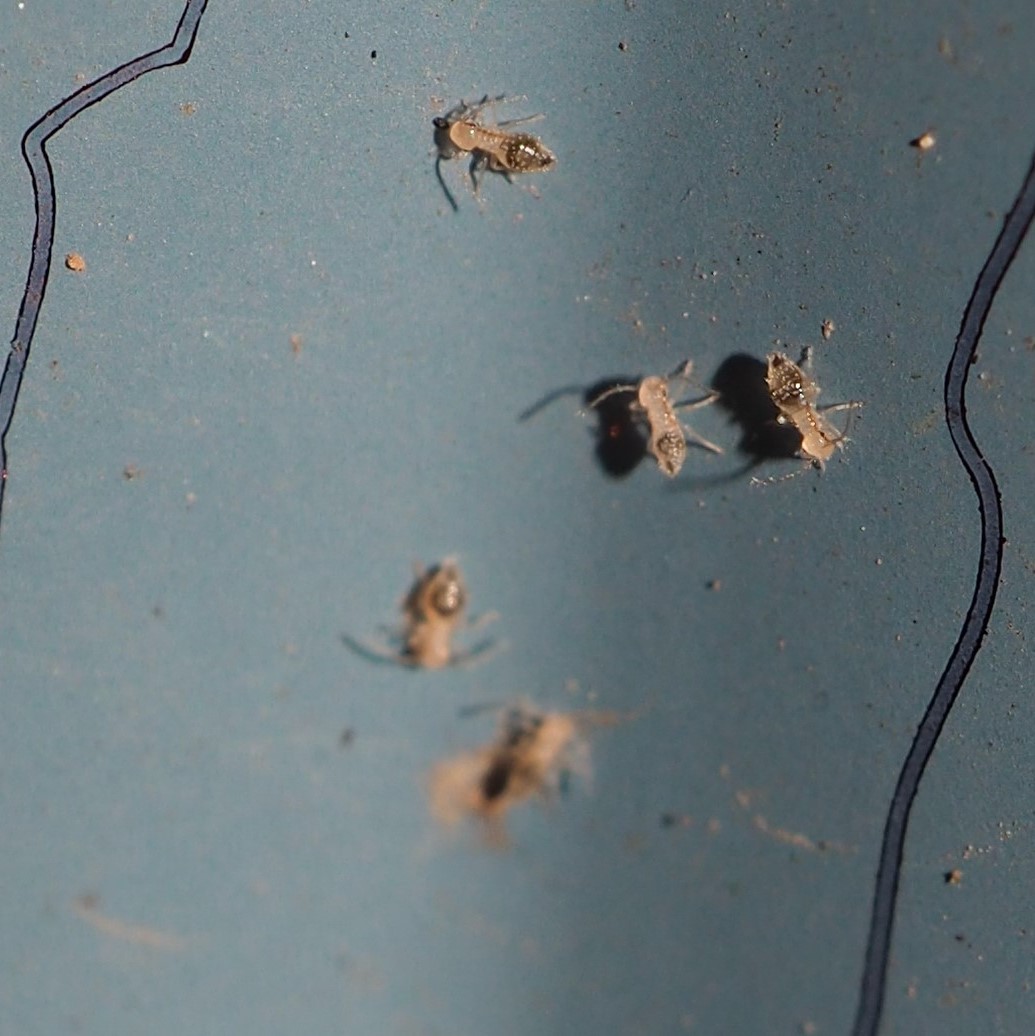
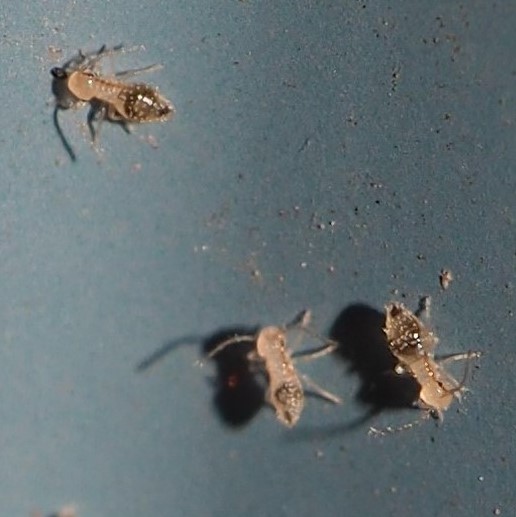
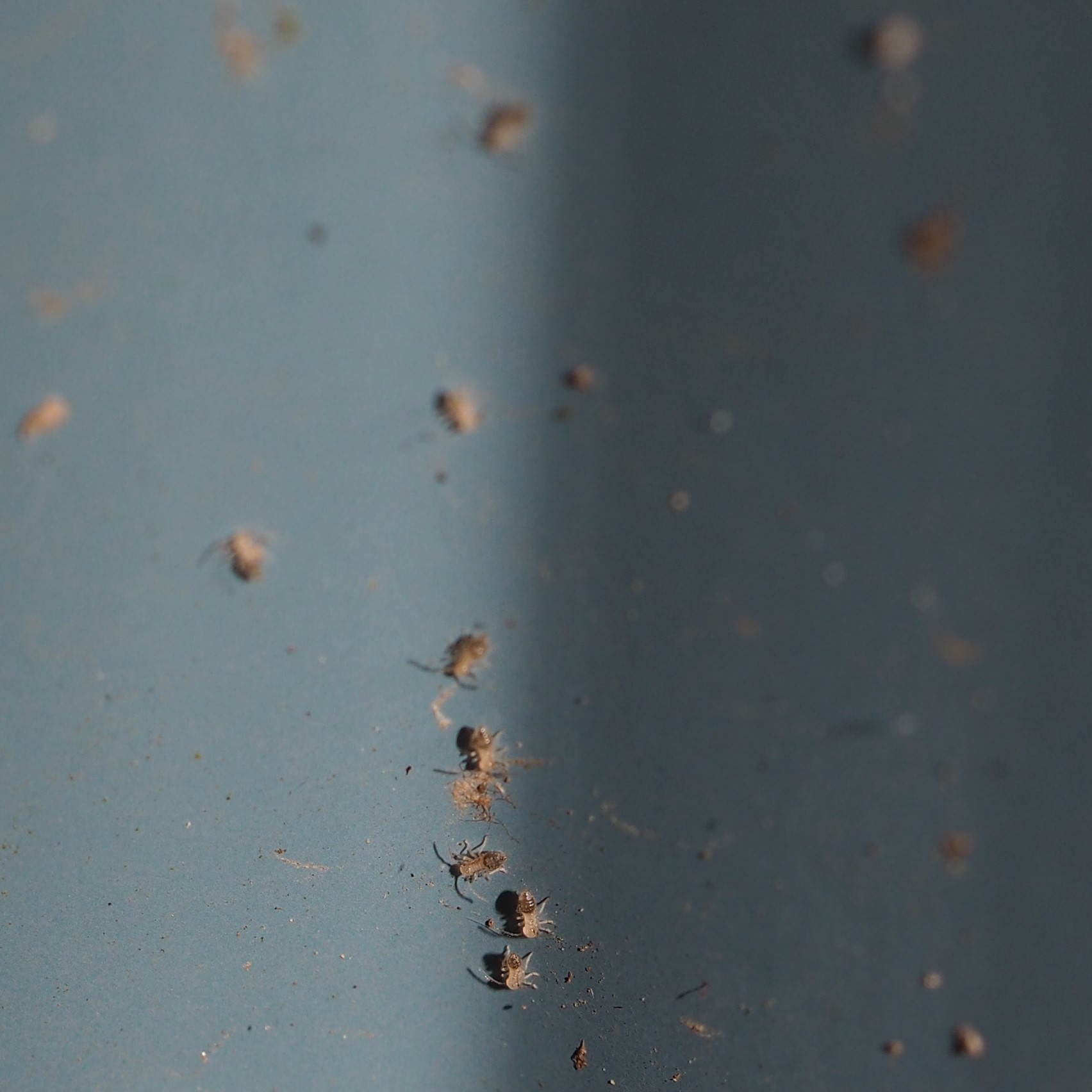
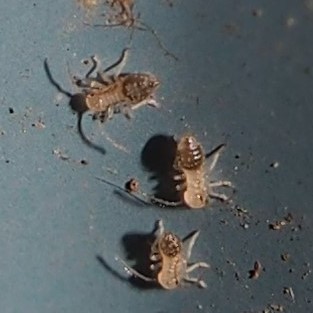
The next day, May 18, rained like crazy. When it was safe to go outside, I looked all over the panel on the North Wall where I'd seen all those little nymphs, but they seemed to have been washed away. The Wall was so wet! Finally - there was ONE nymph.

The next day (May 19) I finally saw, near a big bolt holding the siding together, a little enclave of three little nymphs clearly like the ones from May 17.
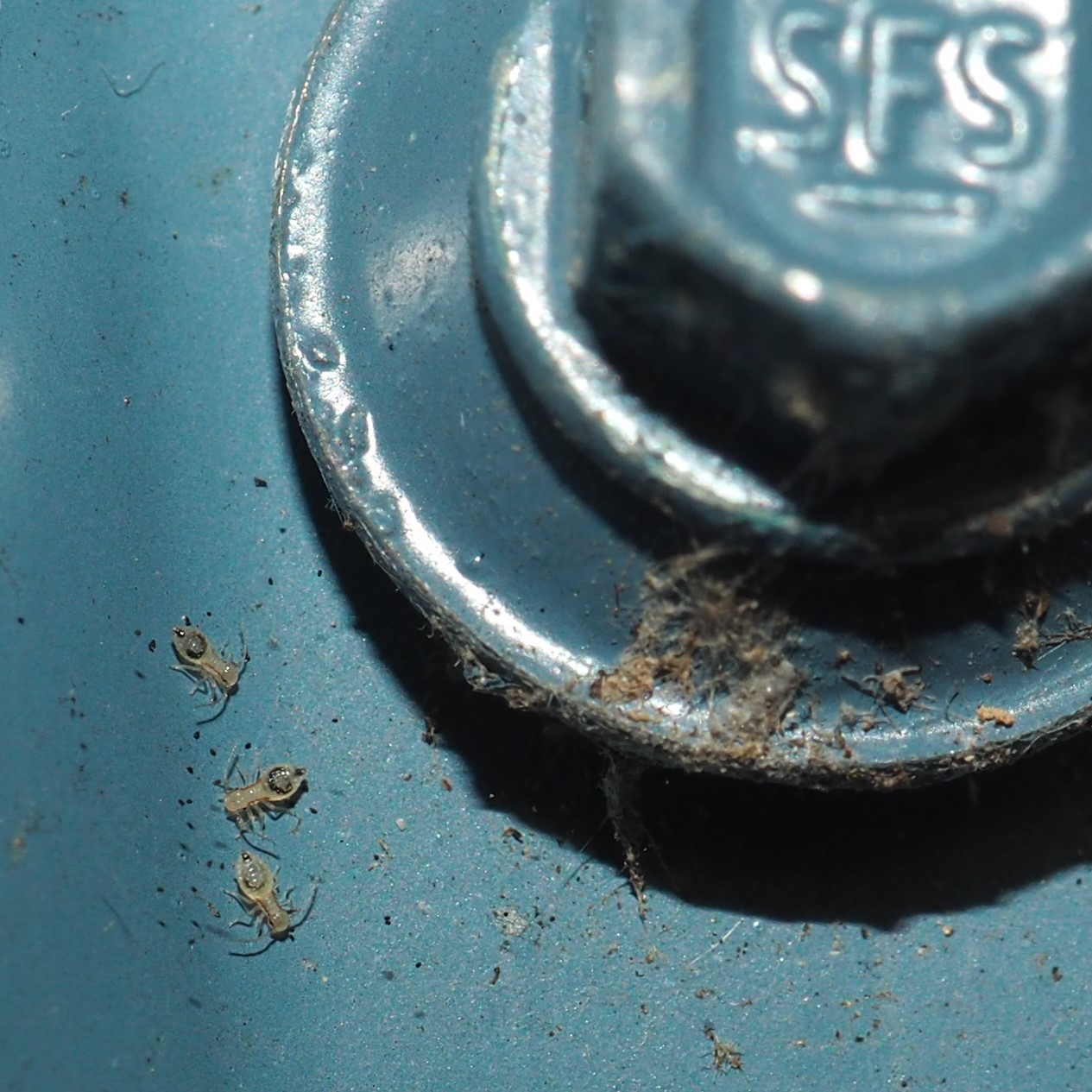

By the way, on May 21, back over on the East Panel the nymphs are getting still longer wings. I was especially surprised to see on May 22 the third nymph. It is particularly long and with good wing development. It also seems to have just emerged from the skin at top. Scott- it almost looks as if it has an extended thorax. What do you think? Maybe it gets stretched out as it moults.
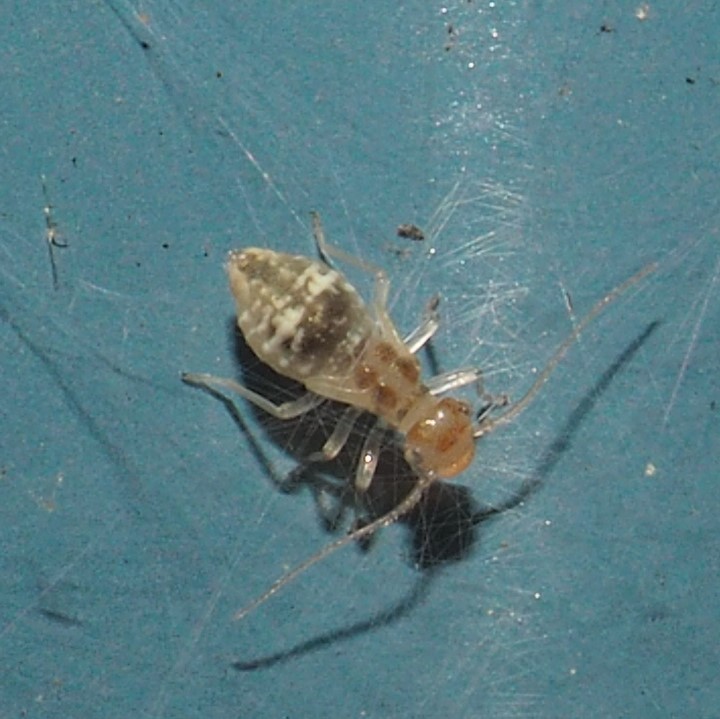
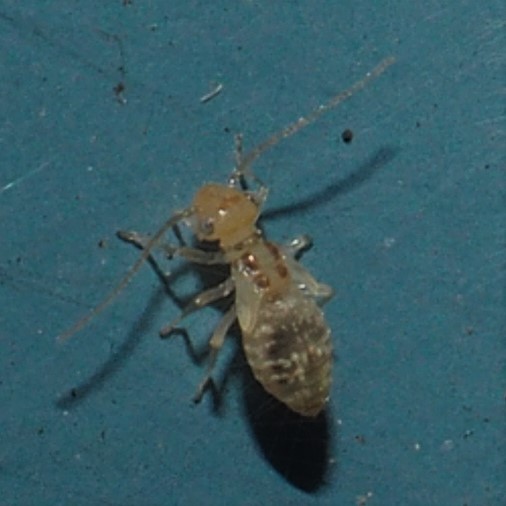
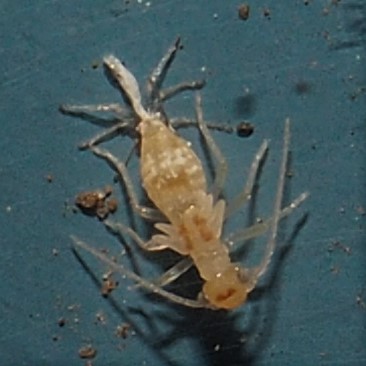
Back to the North Panel. The new babies seem to have been dispersed by the rain. On two panels in particular, 2 and 4, there are fair-sized groups of the babies. First is the group from May 21. The next two bunches are from May 22.
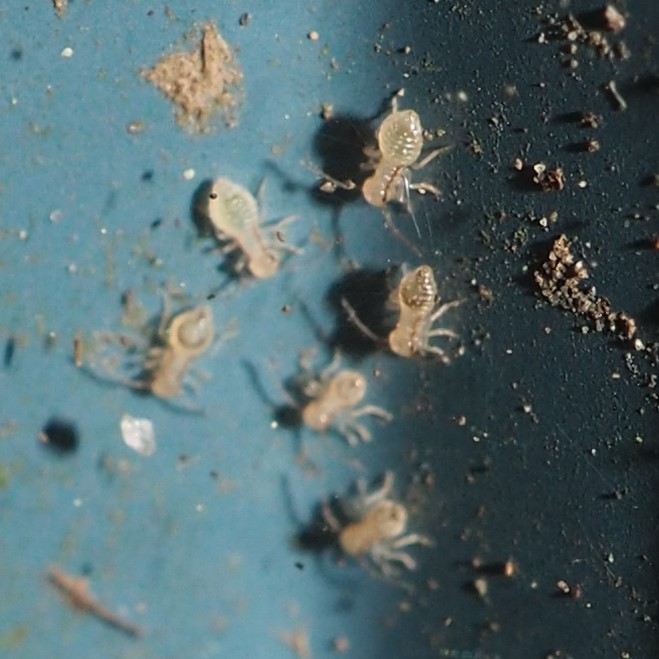
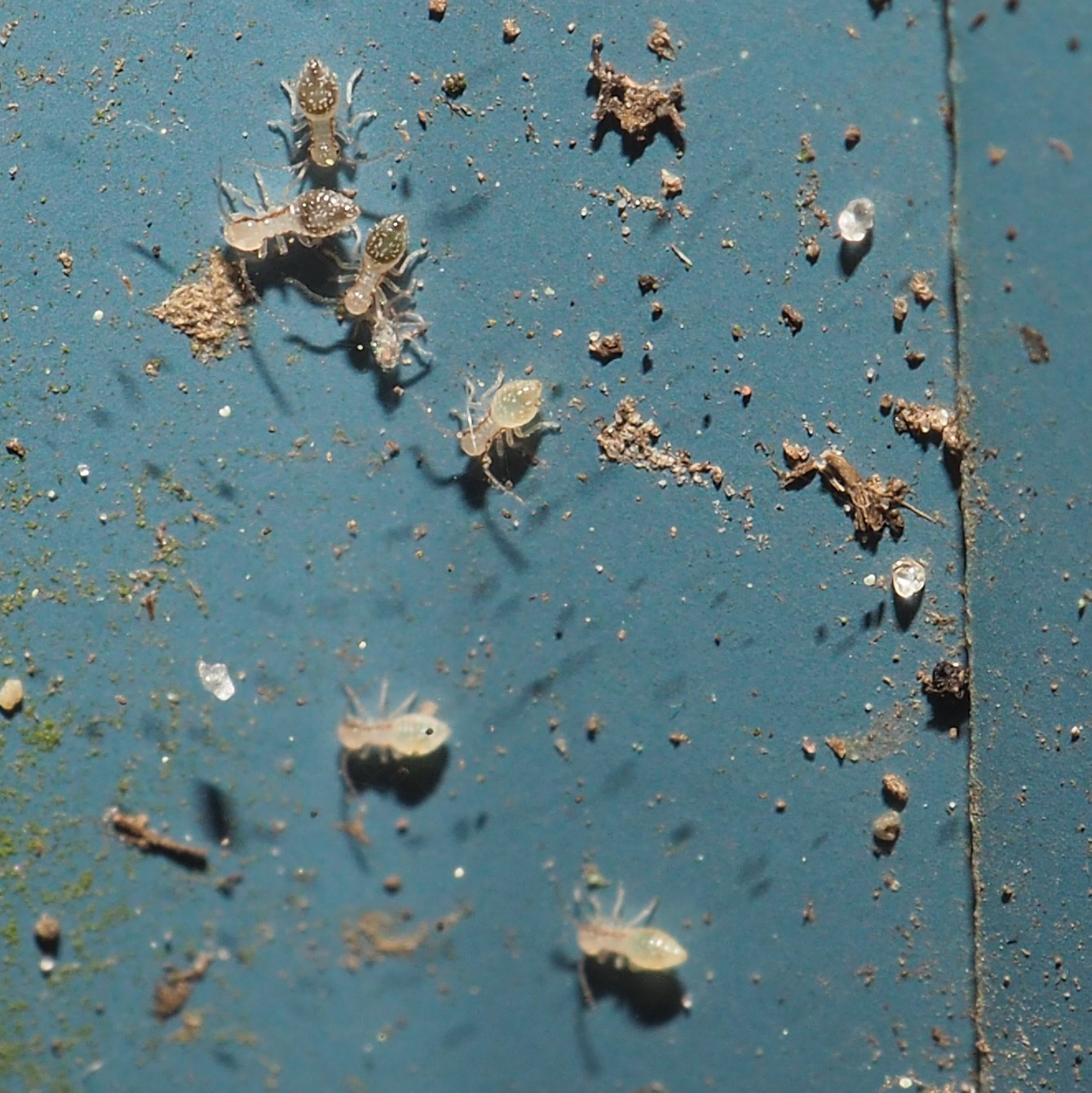
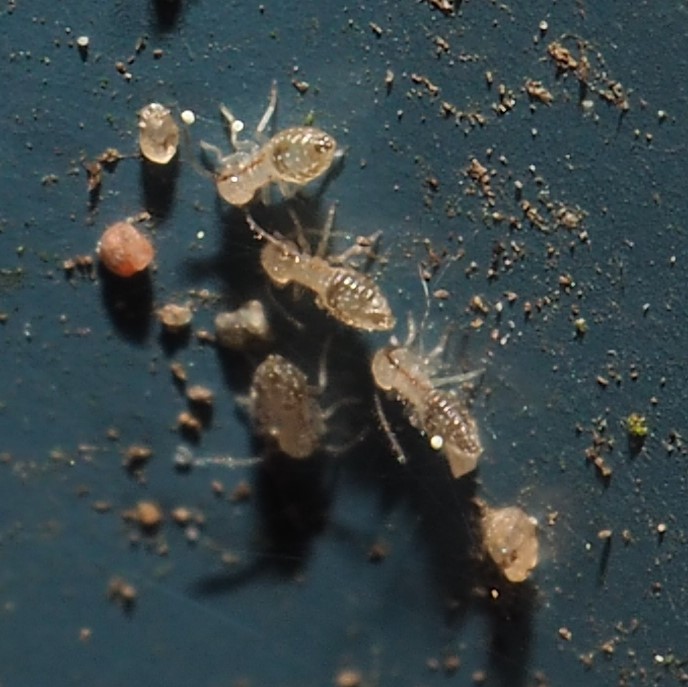
On the East Wall, the G. cruciatus nymphs continue to grow. In picture 3, taken on May 24, the nymph has the longest wings and biggest eyes yet.
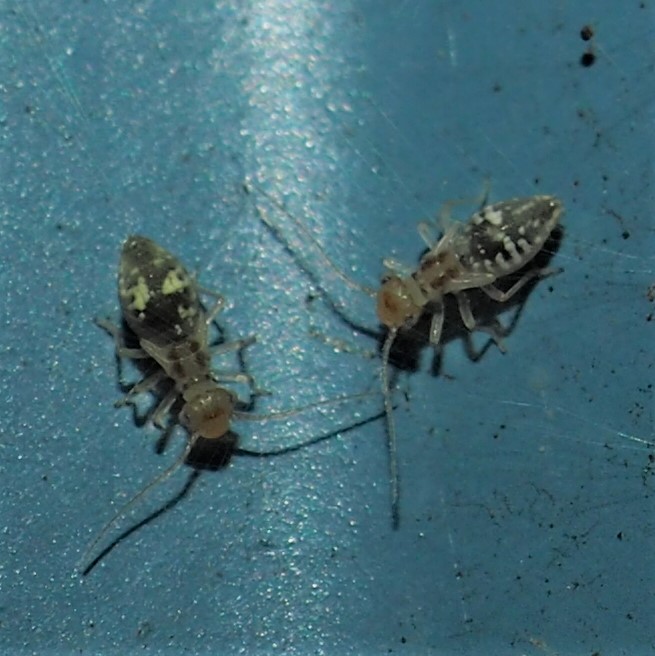
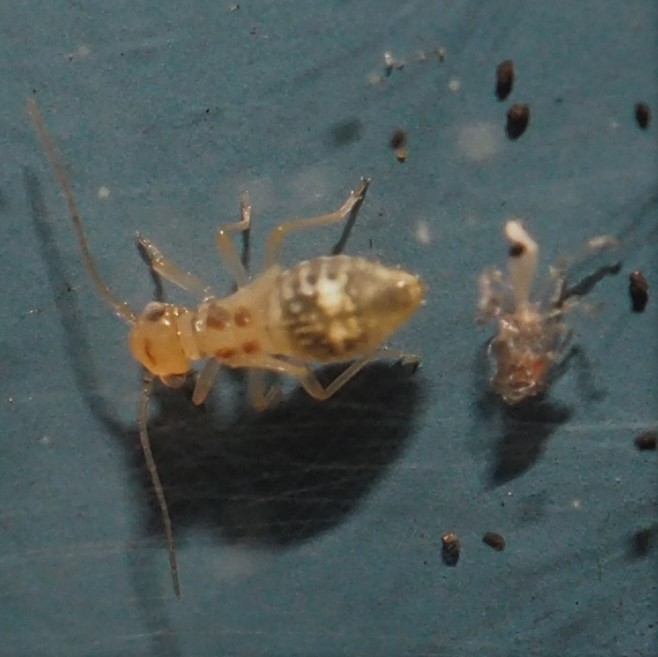
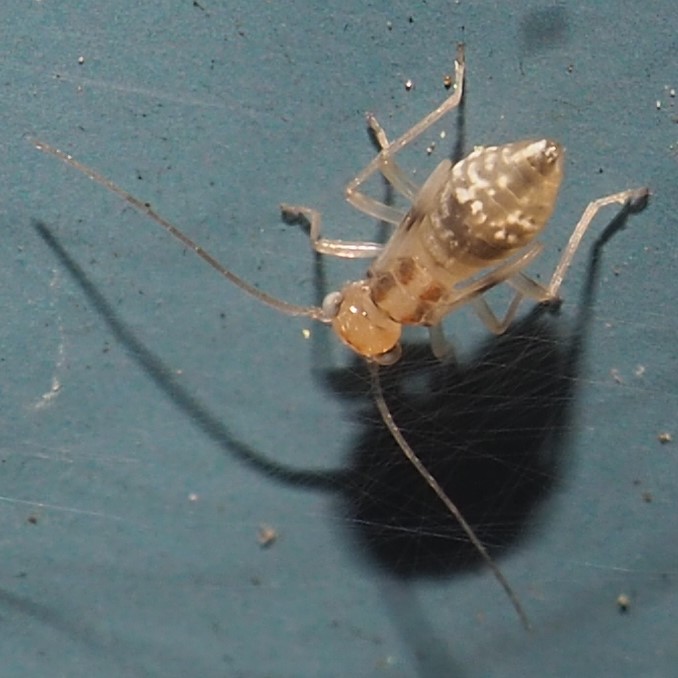
Today, May 24, is one week since spotting the tiny nymphs on the North Wall. They are still very hard to see but I'd say marginally easier than last week. They concentrate an inch or so above the bottom of the Wall. Today we saw groups on panels 1-4. In picture 3, you can see more clearly the longitudinal stripes. My colleague, Scott Shreves, says that he has seen those stripes in nymphs of various species and genera.
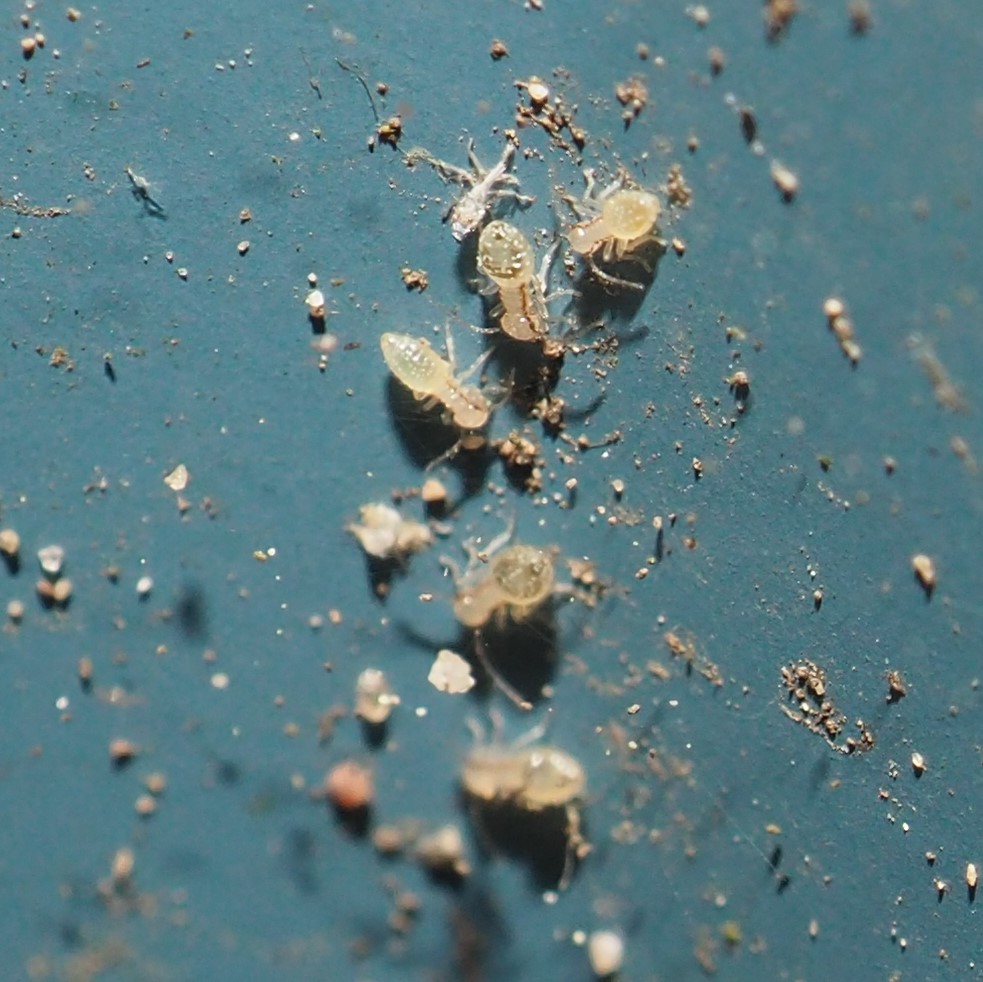
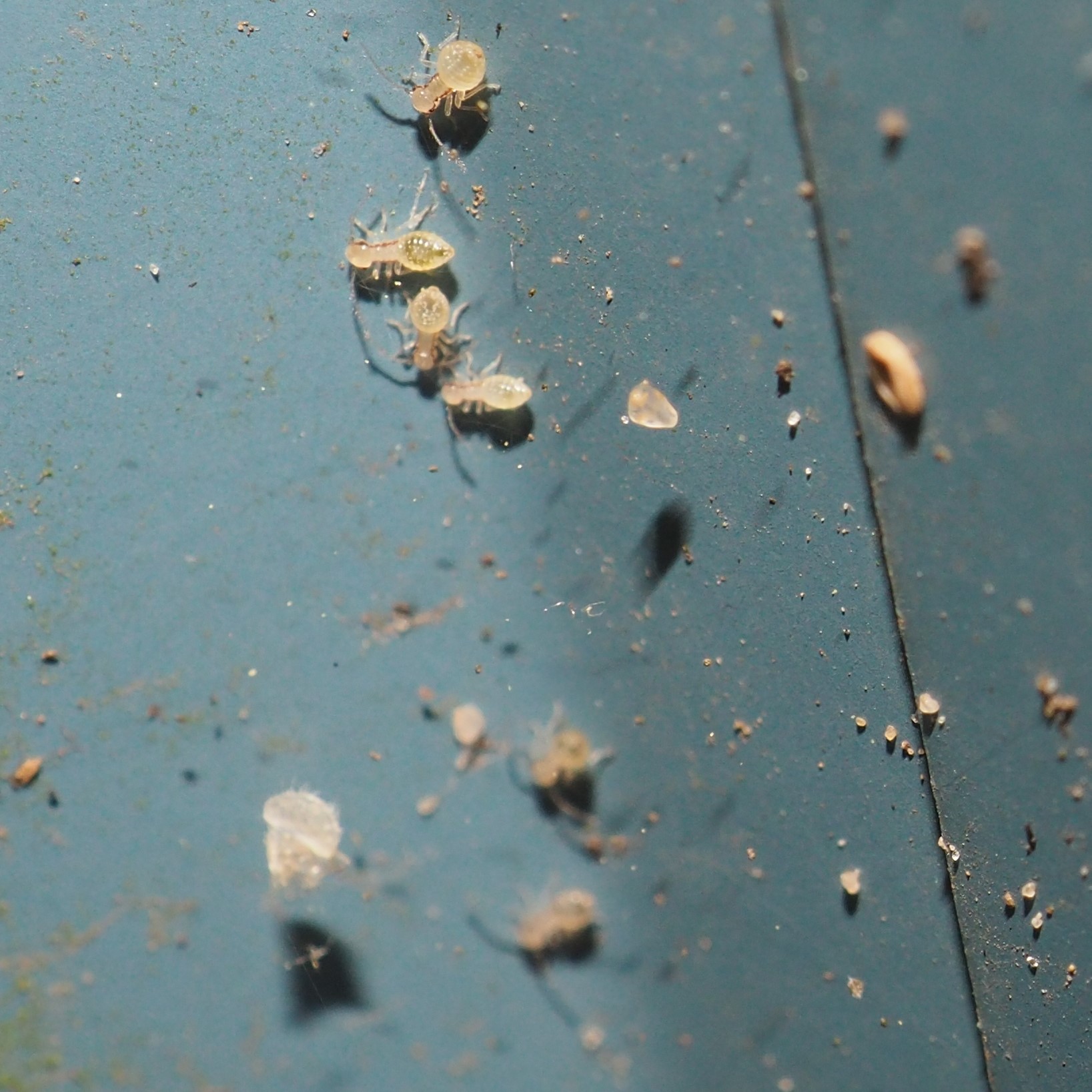
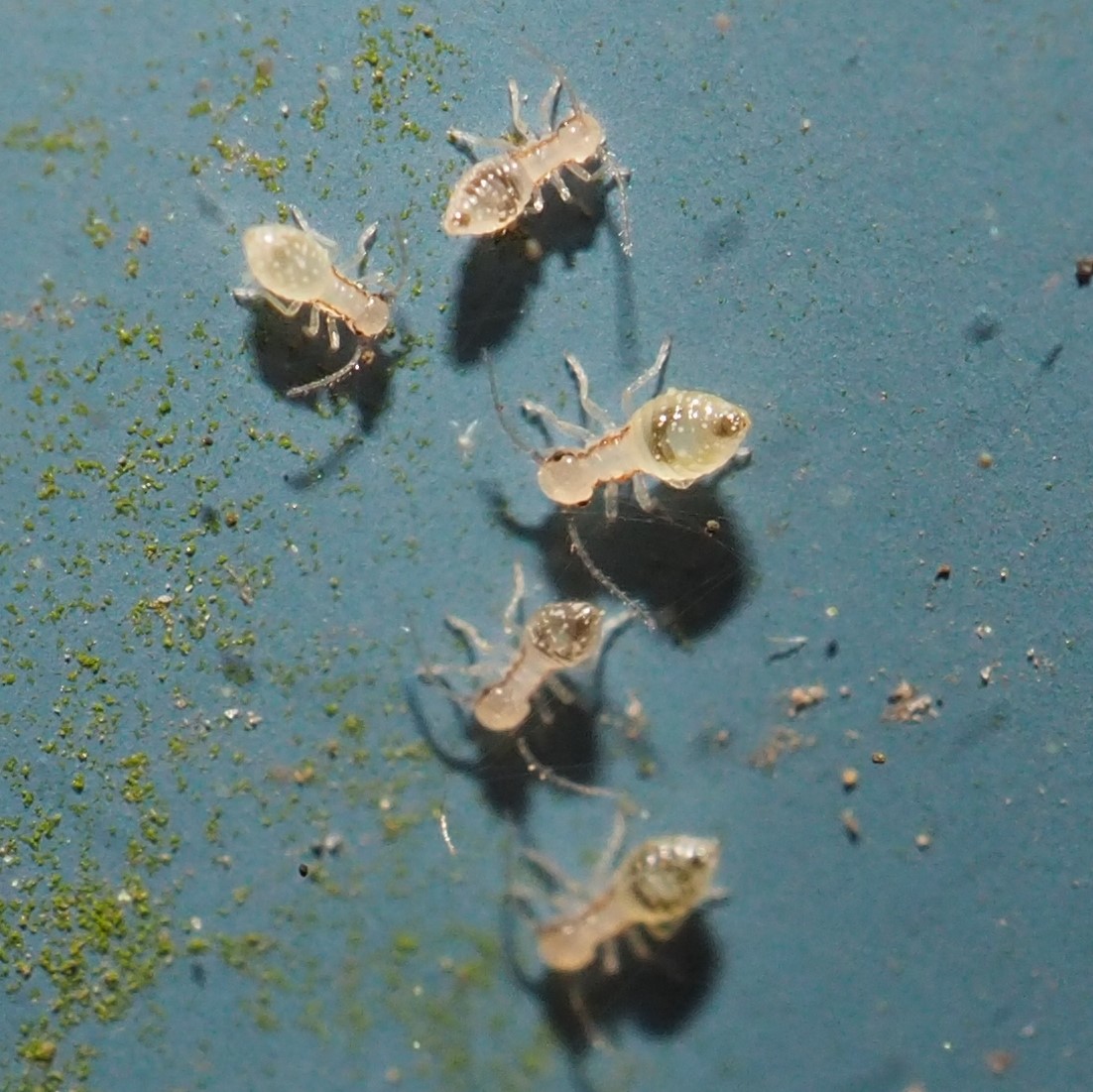
May 26. There has been some counter-clockwise rotation of nymphs. Quite a few of the larger nymphs from the East Wall have migrated to the North Wall. In quite a few cases, the migrants seem to be older with longer wings. One thing we can say about the denizens of the East Wall is that their wings ALL have grown - none remain with no wings. First here, on May 25, an easterner on the North Wall sports longish wings. Second, on May 26, one in home position on the East Wall has spun itself a fairly heavy protective web. Third, one of the tiny nymphs from the North Wall has moved to the East Wall. I don't think any of these has wings enough to help them navigate. But I've observed quite a few on the East Wall that move pretty quickly from place to place. So they have the capacity to walk where they like.
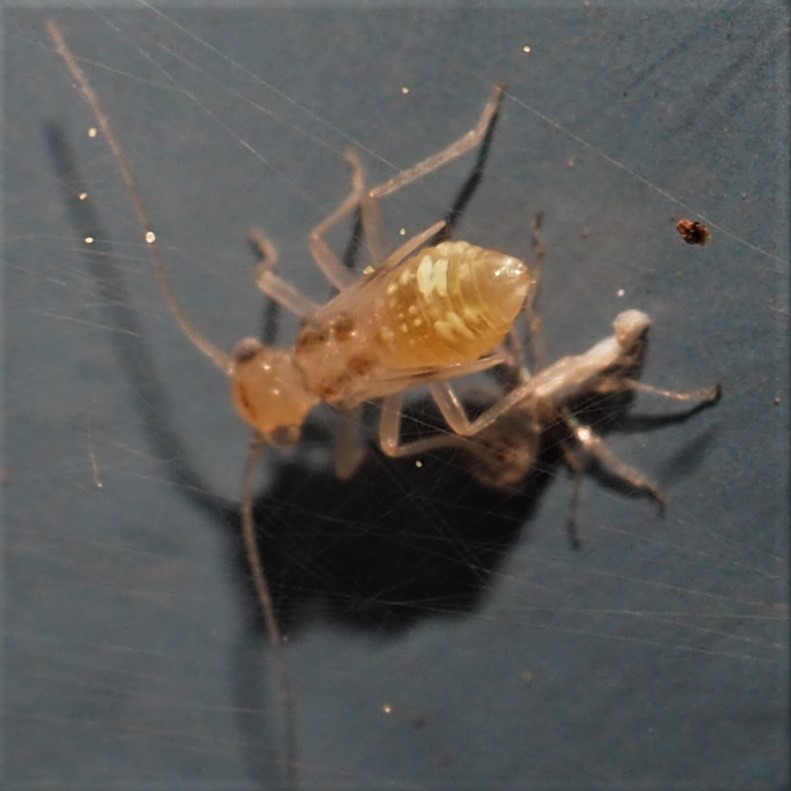
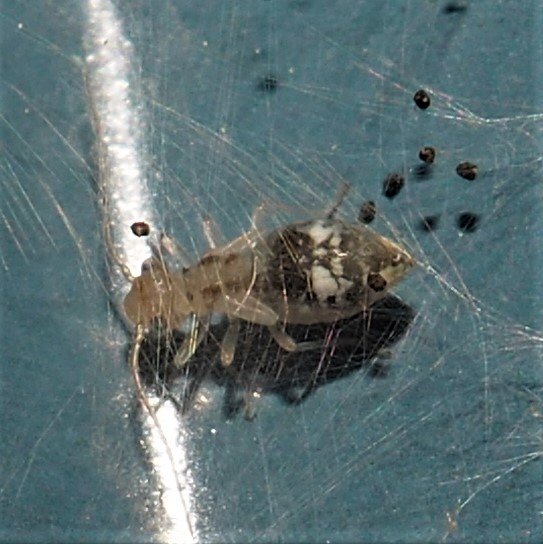
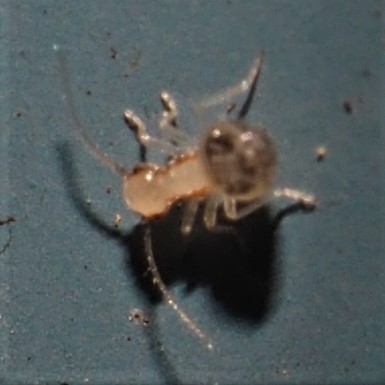
Back to the little striped ones on the North Wall. I'm beginning to be able to see them, especially if they are grouped together, which is common. I don't know if they are grouping for protection, but they definitely do group. But actually, they are perceptibly bigger than they were a week ago.
First, a nicely developed one from somewhere on the North Side. Second, a little group from Panel 4 on the North Side. Third, some of the nymphs from Panel 1.
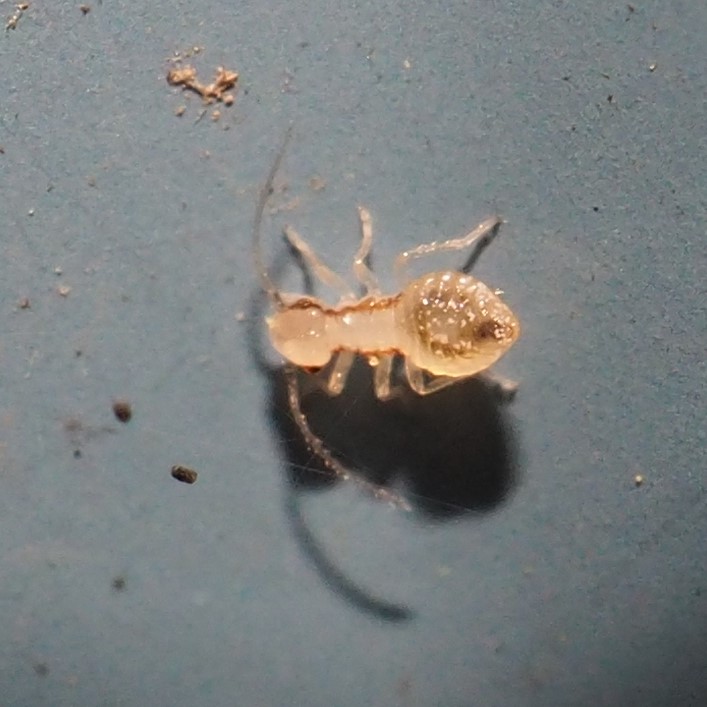
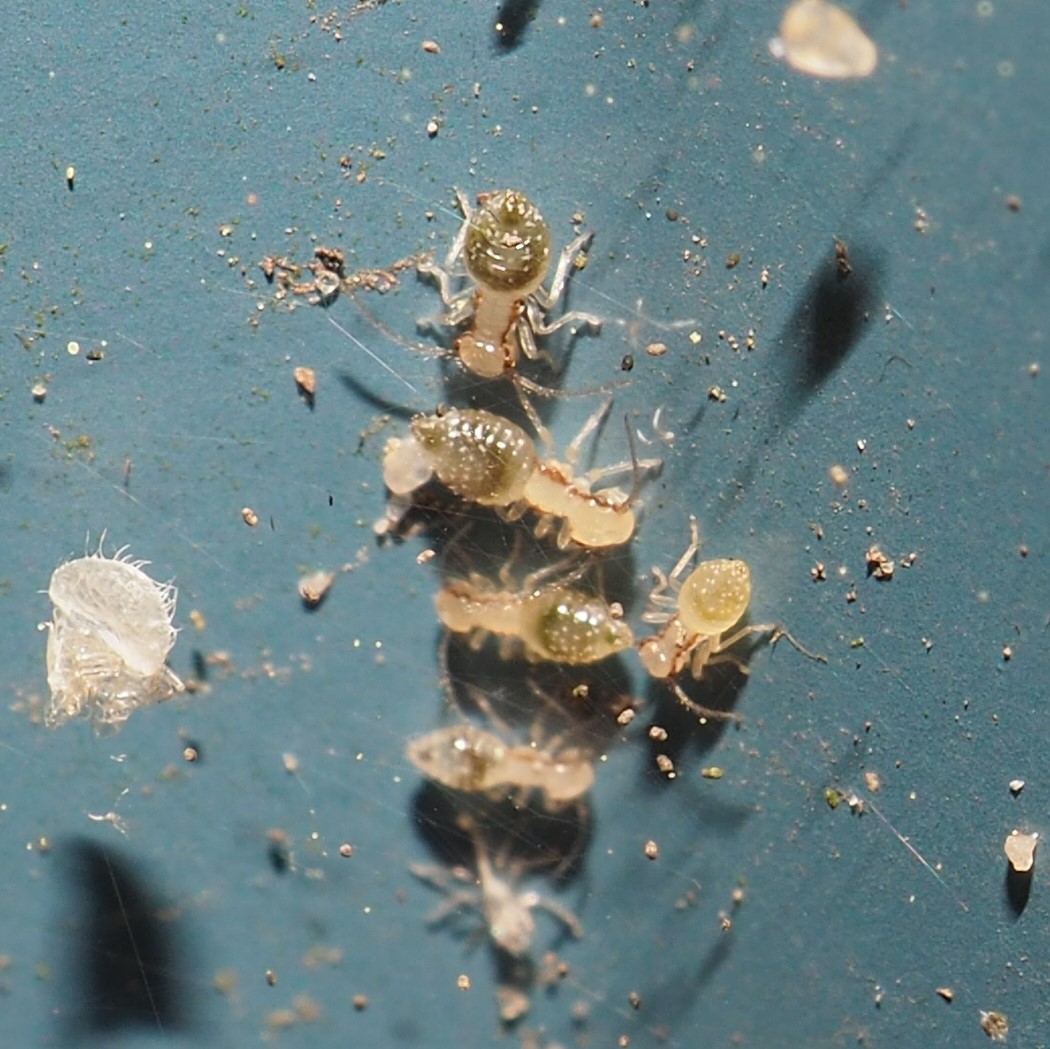
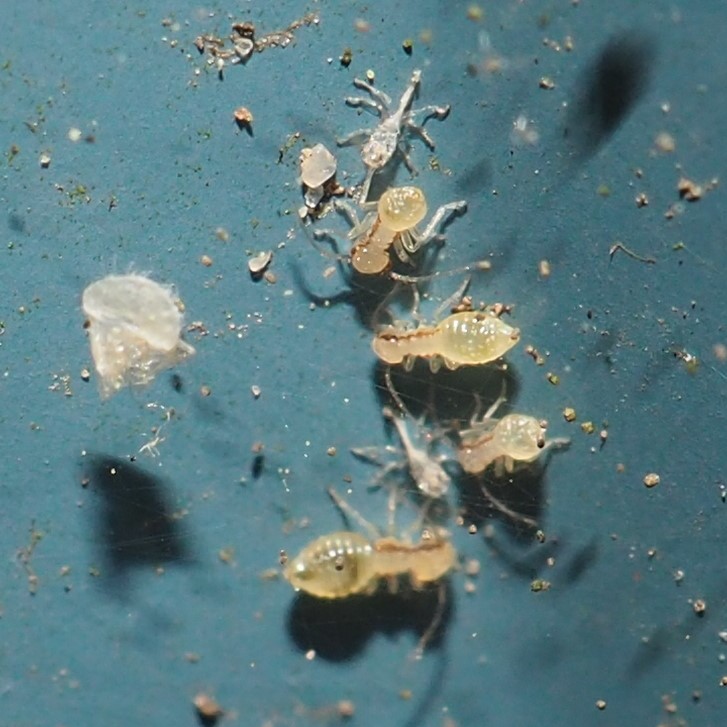
I finally was able (May 27, about 9:30 am) to catch one of the tiny nymphs in action on the North Wall (panel 1). You can see that although they are very small, they are capable of running around and it seems that this one has found some edibles. They also don't seem to like bright light. Maybe this is why they always seem to be found in the shade at the edge of a panel.
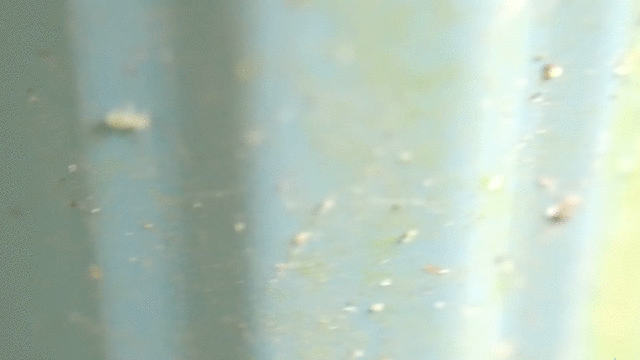
A couple of odd things happpened on May 27. First, on the East Wall there appeared a yellowish nymph that was a real runner. When I would turn the camera on it, it would stop in its tracks and not start running until I removed the camera. Its color reminded me of the little nymph from April 2.
Now I'm wondering if they are members of a different group. The second odd thing that happened is that suddenly after not observing any adults since fall, a Valenzuela flavidus adult swept into view on the North Wall. Note 1: This adult has red thoracic markings that could easily be the end-product of the nymphal thoracic spots. Question: is this adult the natural continuation of the East Wall colony nymphs that had moved onto the North Wall as they grew? OR Question 2: Is the adult the result of the growth of the yellowish nymph we saw on April 4 and on the yellow fast runner from May 27 on the East Wall? Other questions come to mind: If the yellowish nymphs are truly a different strain of barklouse (note that the yellow nymphs and the fast runner and the V. flavidus adult all have red eyes, then where have they been developing? To throw a monkey wrench into this argument, note that the V. flavidus adult HAS got red thoracic decorations. That's a lot of questions. The good news is, we still have observing to do!
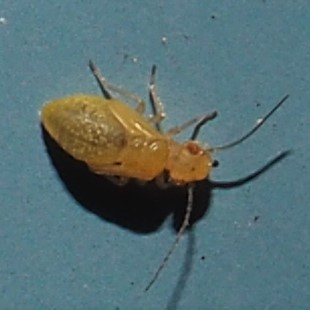

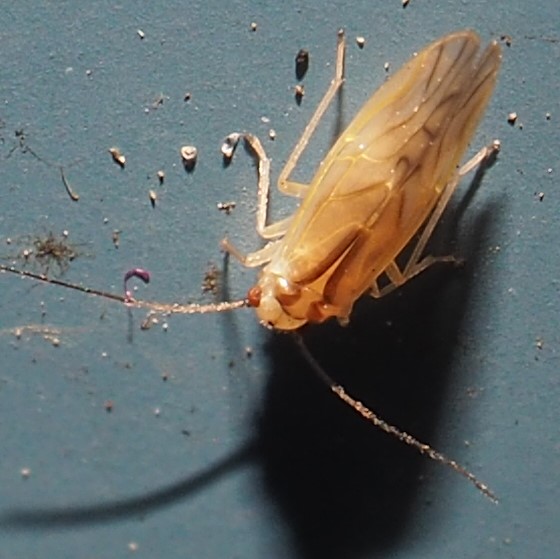
May 29. Something that we knew must happen has happened. Look at the little barklouse nymph in picture 1. It has already gotten its wing buds started! Picture 2 shows two North side nymphs in new protecive webbing. Picture 3 shows an adult Graphopsocus cruciatus almost to the end of the North Wall, a bit further to the right than the adult Valenzuela flavidus we saw the other day. This thing is getting stranger and stranger! I'm about ready to say the nymphs that started out on the East Wall and migrated slowly to the North Wall will be G. cruciatus adults. It's a guess. But who are the nymphs born on the North Wall?
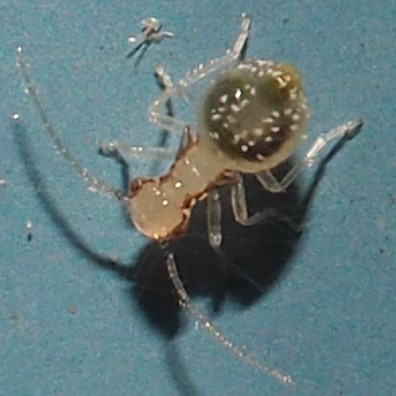
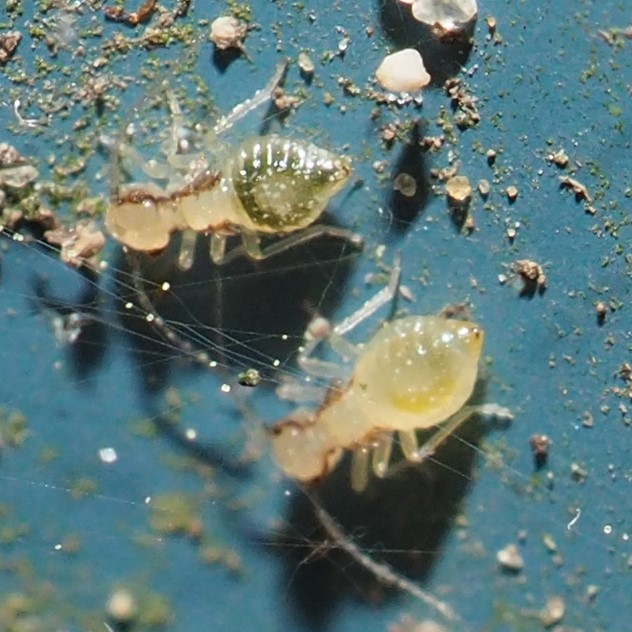
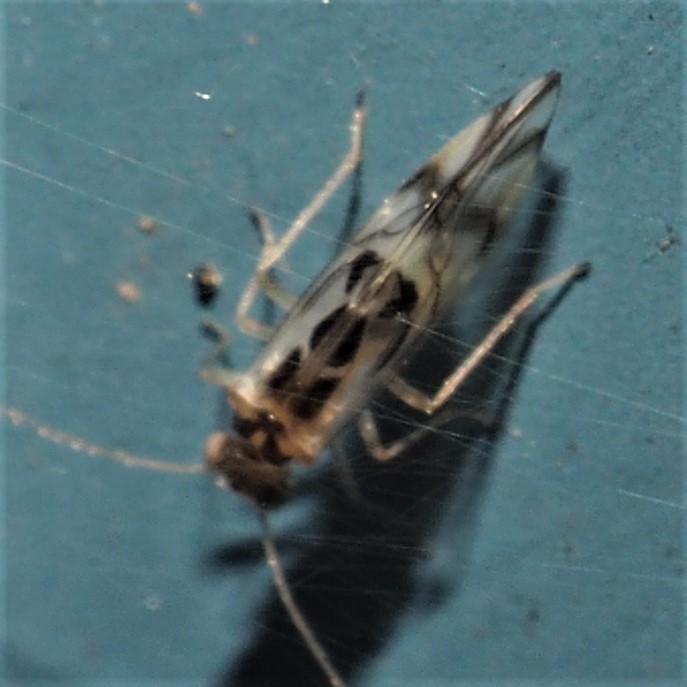
In fact, I'll go stronger than that. The former east-side nymphs have been replaced in their webbing by adult Graphopsocus cruciatus. As of today, May 31, we have adult Graphopsocus cruciatus barklice in 8 webbings that formerly housed east-side nymphs.
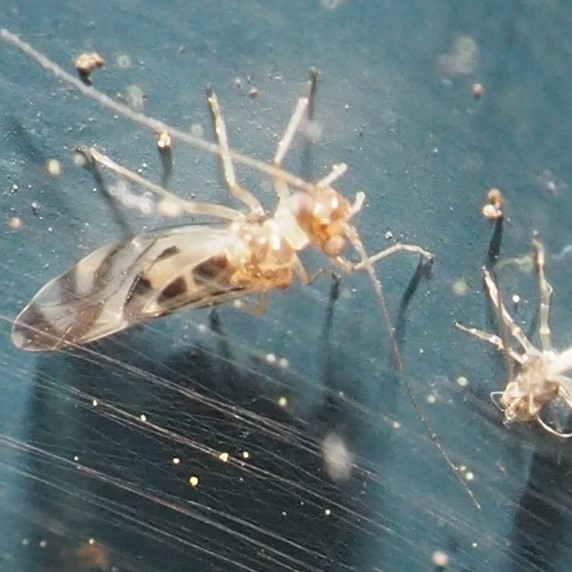
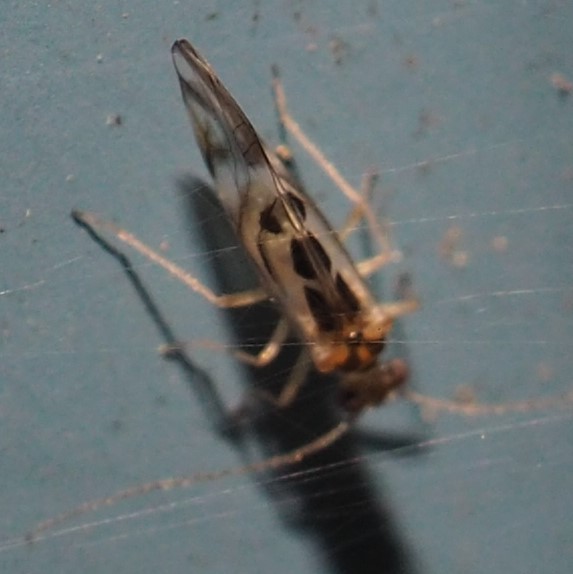
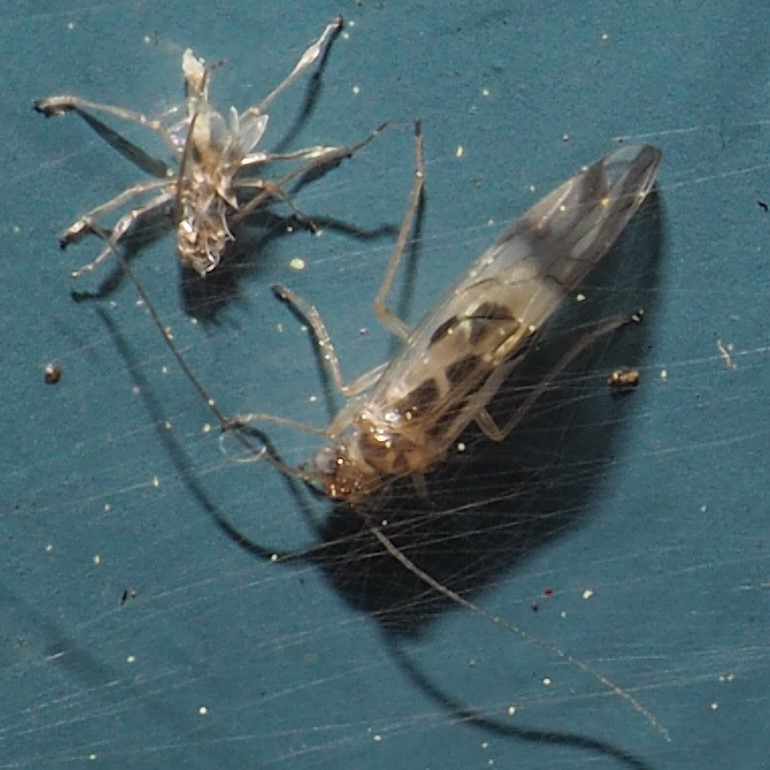
Here we see an adult Barklouse just a bit after eclosing from the last nymphal stage, at 1:00 pm on June 1. Then at 1:14, then at 1:14, then at 2:40, and finally at 4:16. It seems to have transformed itself into a real Graphopsocus cruciatus adult. (When I went back to take one more reading, it had gotten itself out of the webbing. Now (June 5) there are little G. cruciatus all over especially the East Wall, but many on the North Wall.
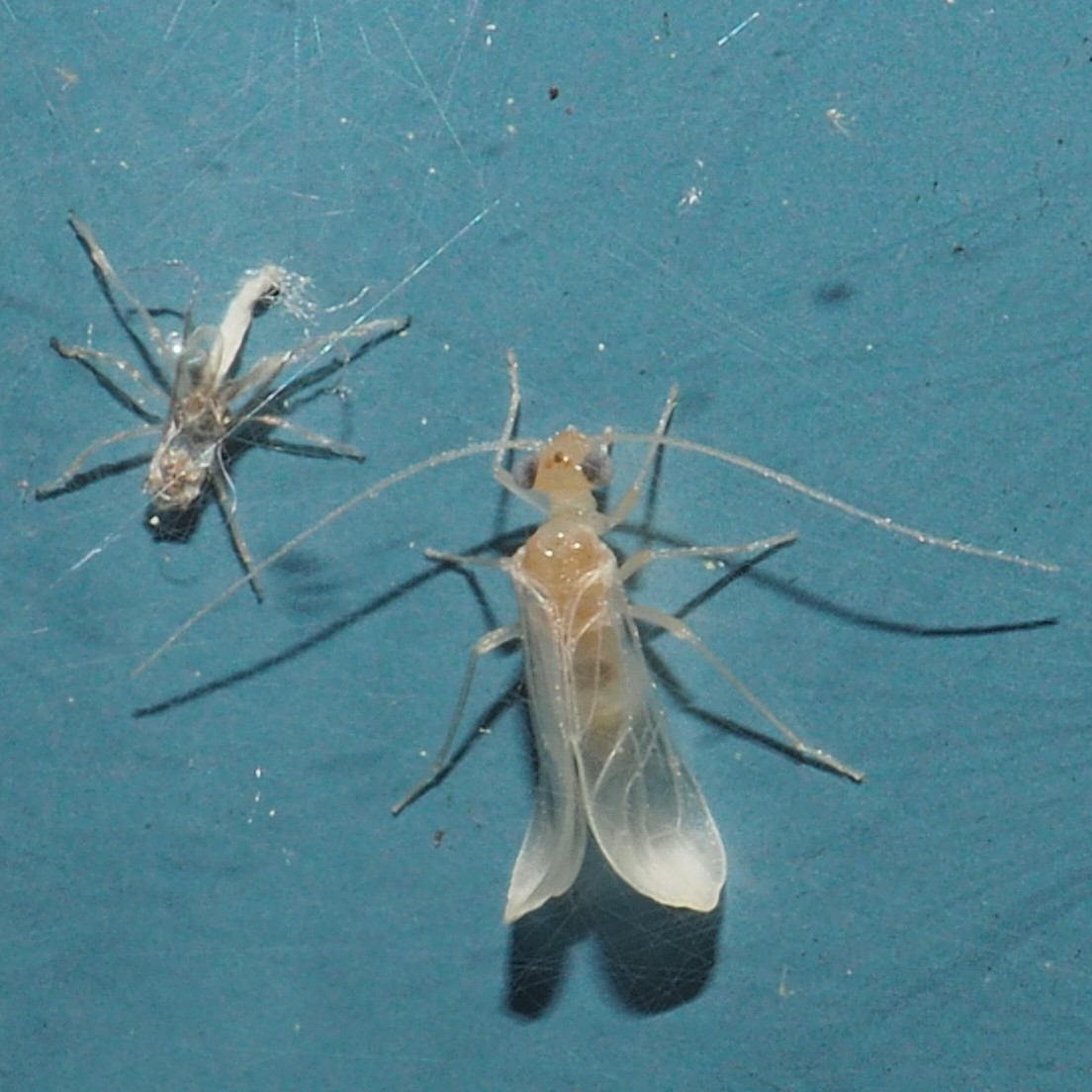
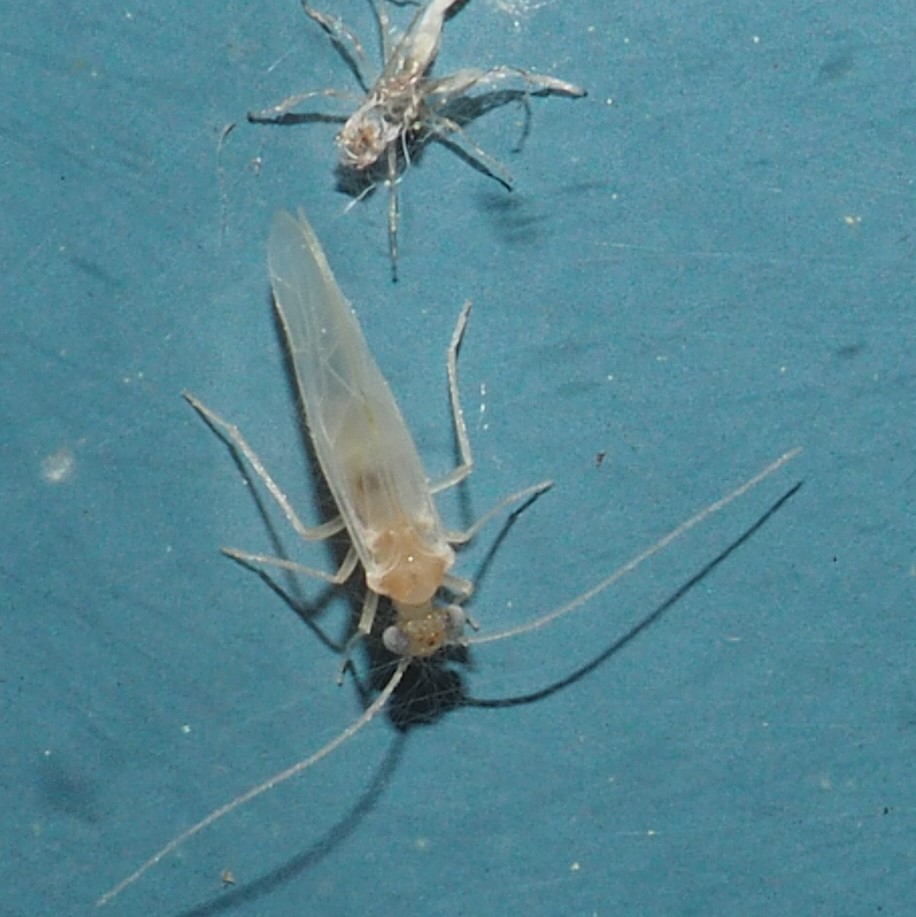
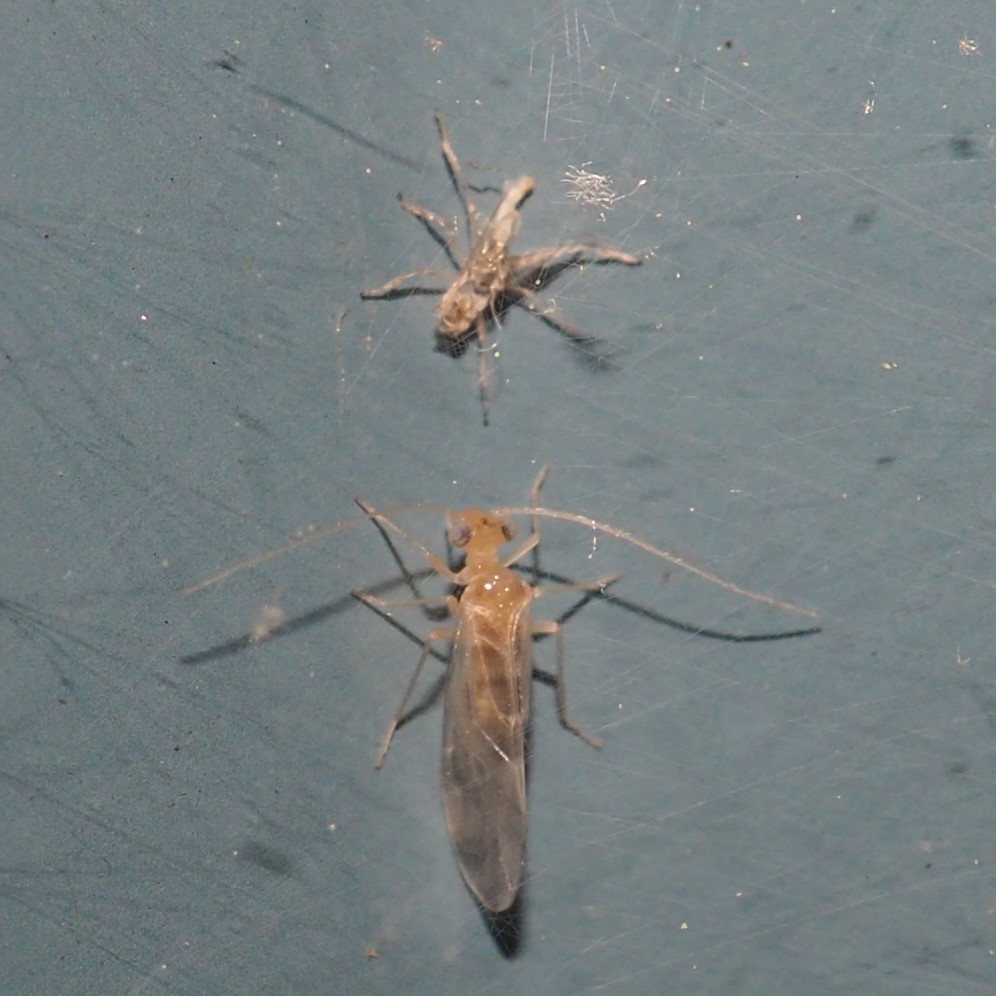
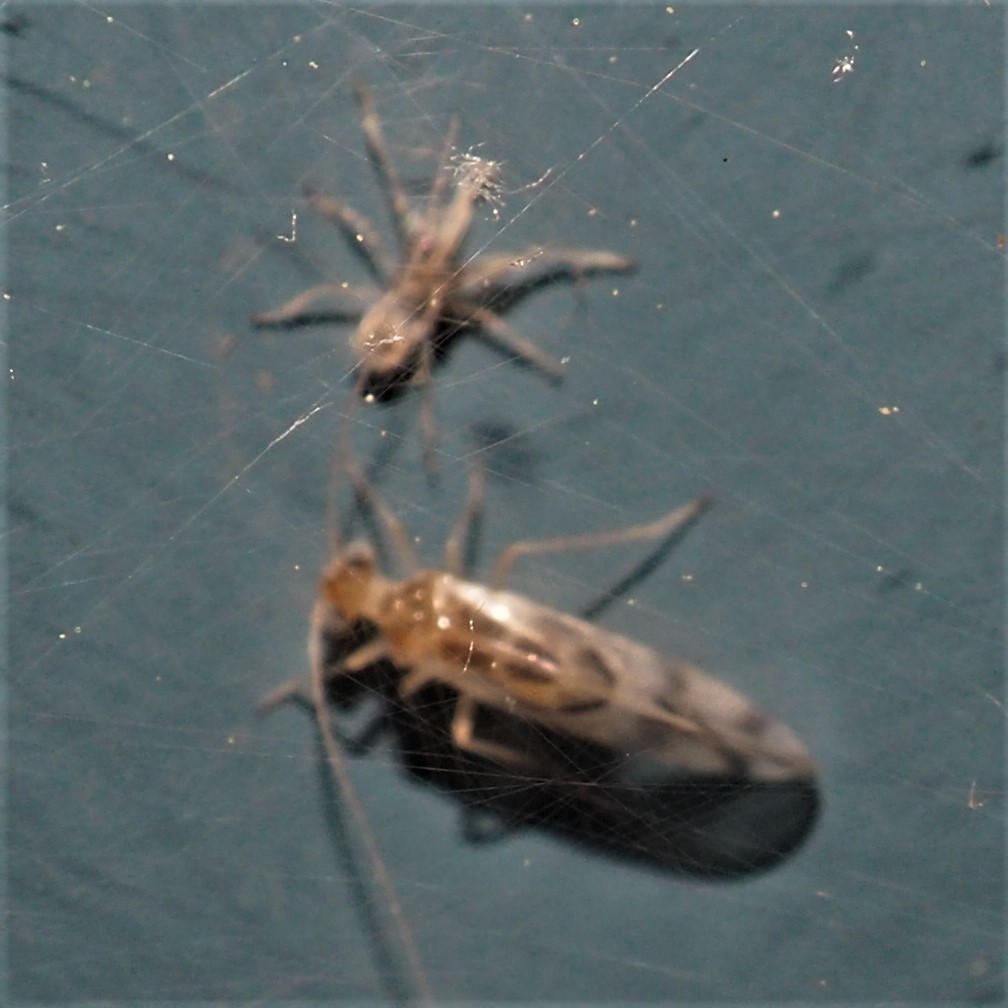
Now we have to wait to see what adults will replace the north-side nymphs. Meanwhile, a (possibly the same) Valenzuela flavidus adult was back today on the north side.
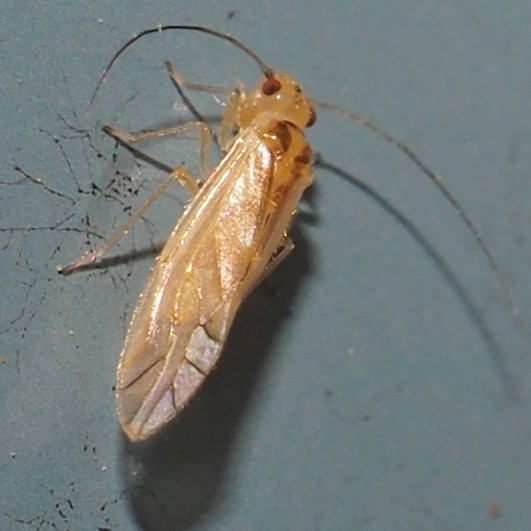
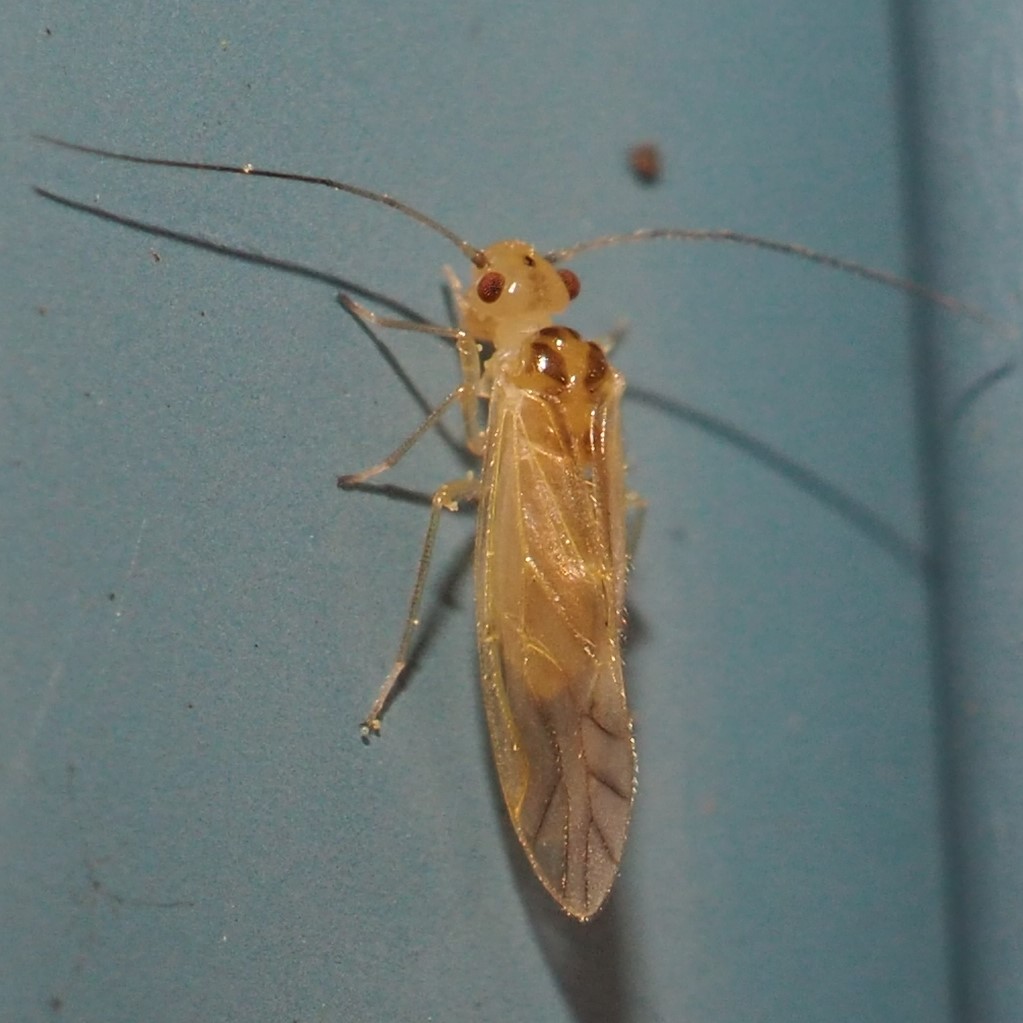
During the week, the young nymphs on the North Wall seem to be thinning. As of June 4, there are still a few, and they are continuing to grow. Picture 1 shows one with bigger wings. Picture 2 was on the bottom rim of the siding.
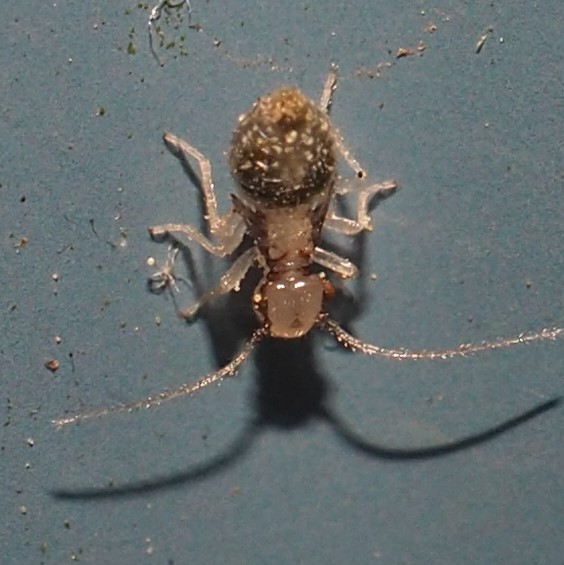
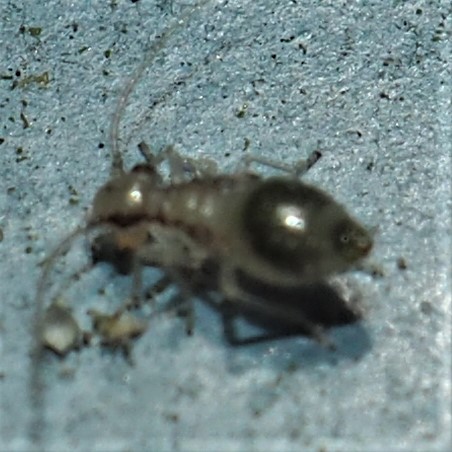
I spent a lot of time out there watching the nymphs on the North Wall. Suddenly it hit me - there are many little spiders and it came to mind that they MIGHT be picking off our nymphs. In the afternoon I chased away a spider to see that it had already wrapped up a nymph (picture 1). The wrapped victim is shown in picture 2. A couple of the North Wall nymphs meantime had moved to the East and South walls (picture 3).
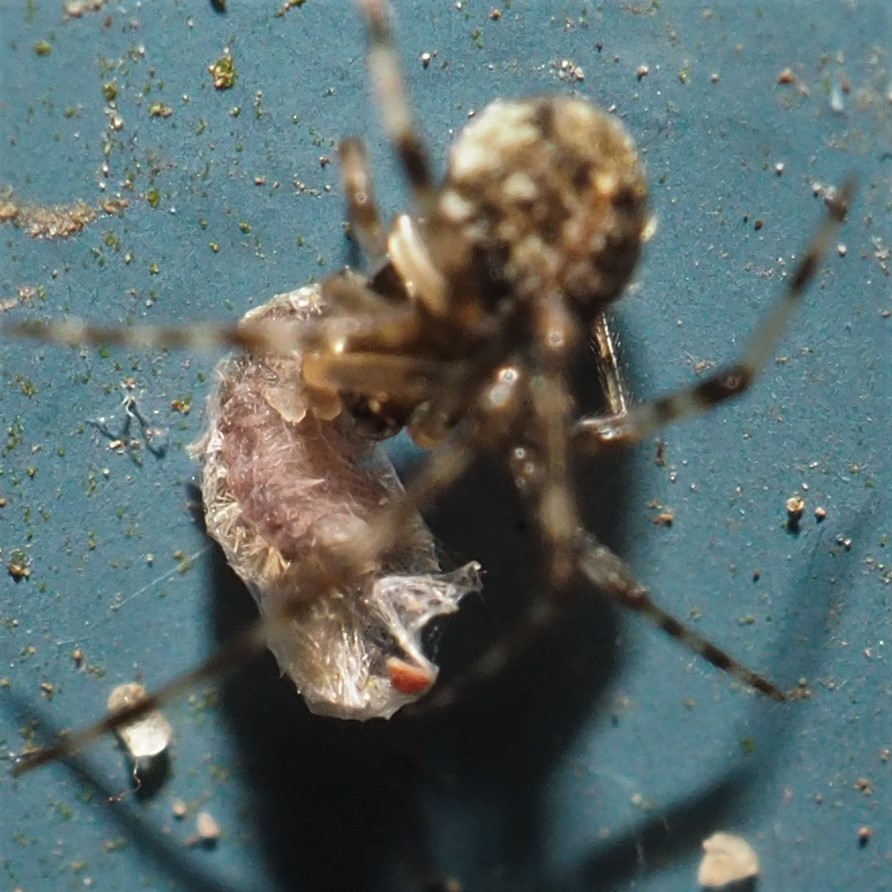
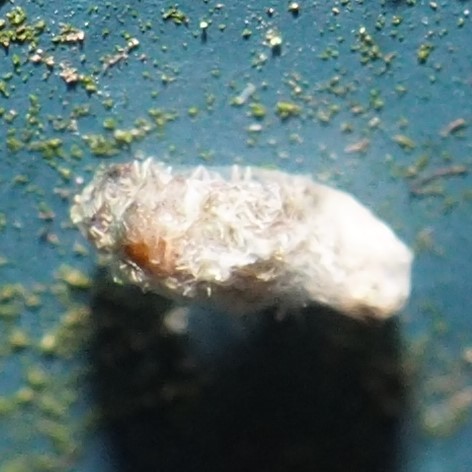
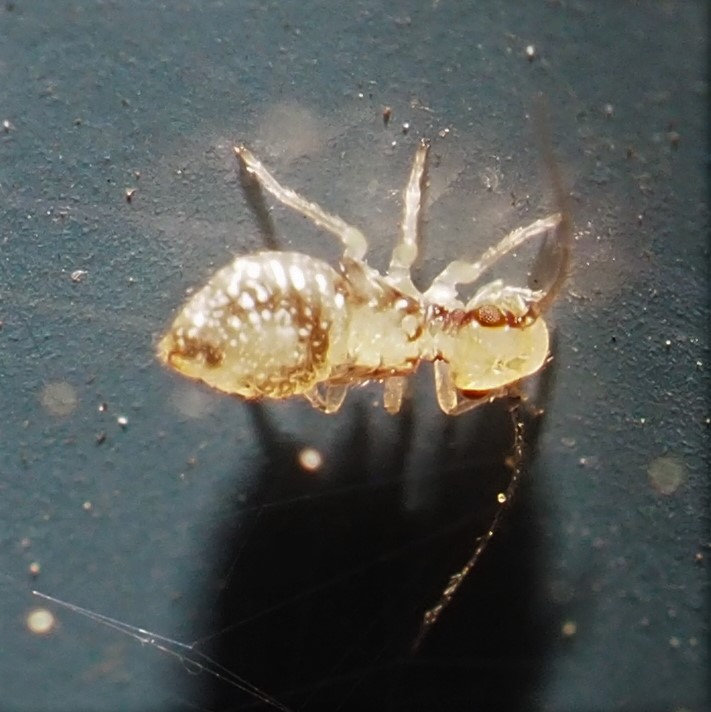
A few days ago, a new kind of Barklouse nymph began to show on the East and South walls. They are yellowish with bright yellow eyes. (Remember G. cruciatus nymphs had grey eyes, while the North Wall nymphs had reddish eyes.) You might note that they have fairly indistinct thoracic dots. These first three pictures are all from June 3 or 4. In the last picture, the wings are less developed. I wonder how that affects the yellow intensity. I'm adding one last picture from May 31, showing a very much less developed little yellow one. Note: November 3 2021. Those nymphs grew up to be recognizable as Xanthocaecilius sommermanae.

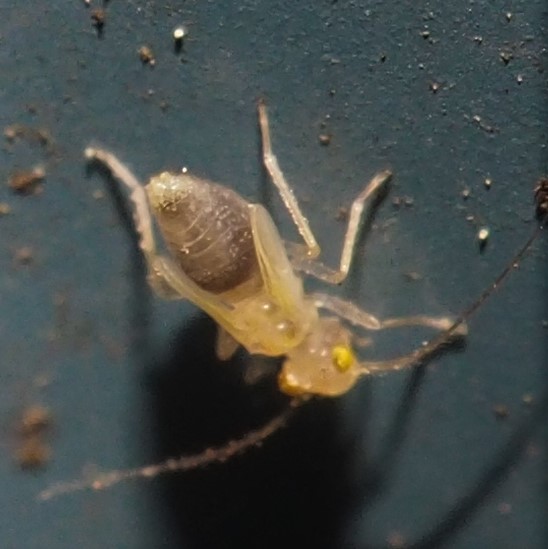
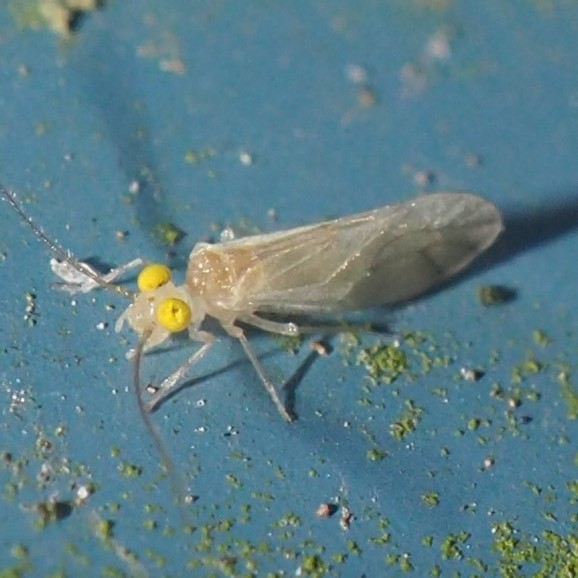
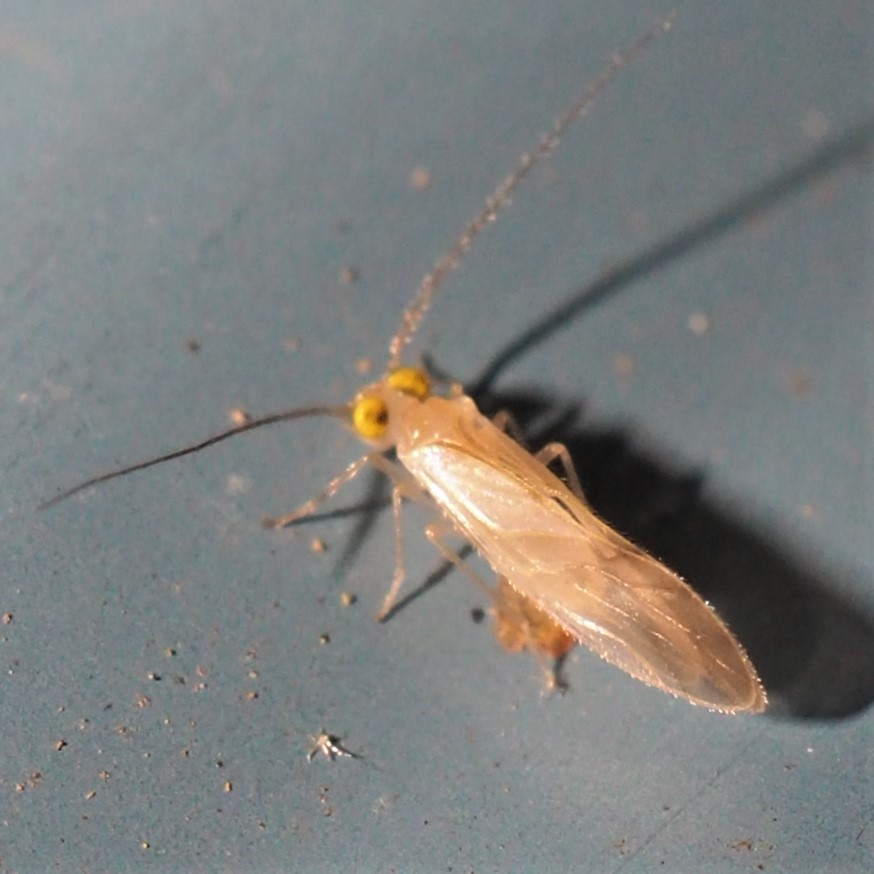
I'll also remind you of the dark yellow nymph that was such a fast runner on May 27. It had RED eyes. But on June 3, I was lucky to get these next two pictures of a yellow nymph with GREY eyes. But notice that the last two may very well not be Barklice, but maybe even Leaf- or Plant- hoppers. Look at how the head joins the rest of the body.
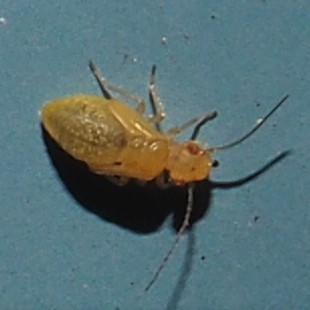
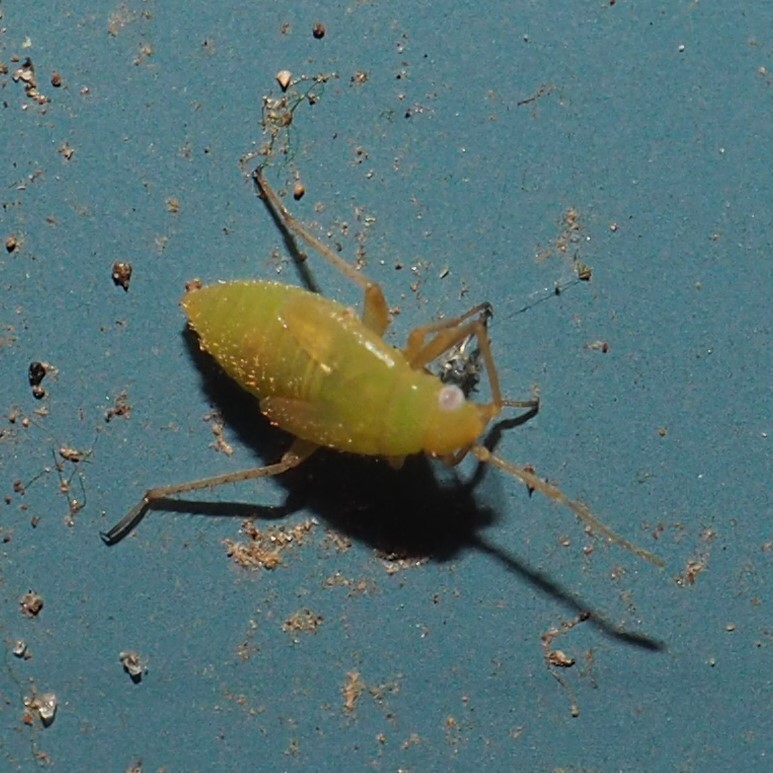
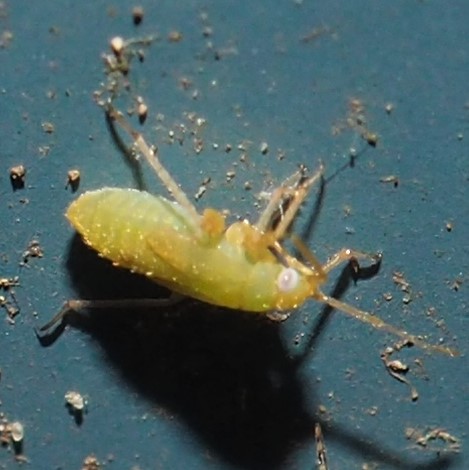
Yesterday, June 5, I saw this bright yellow nymph with red eyes on South Panel 1 (pictures 1 and 2) and this morning it had been replaced by this adult, which looks as if it will be a good match with Valenzuela flavidus (pictures 3 and 4).
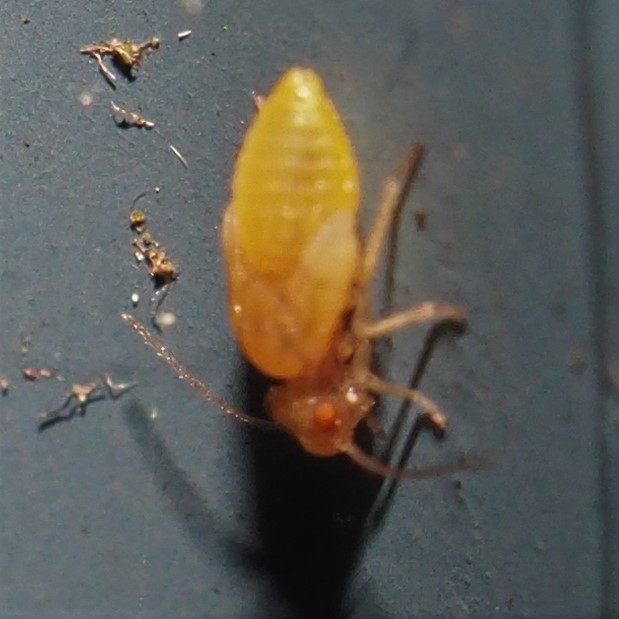
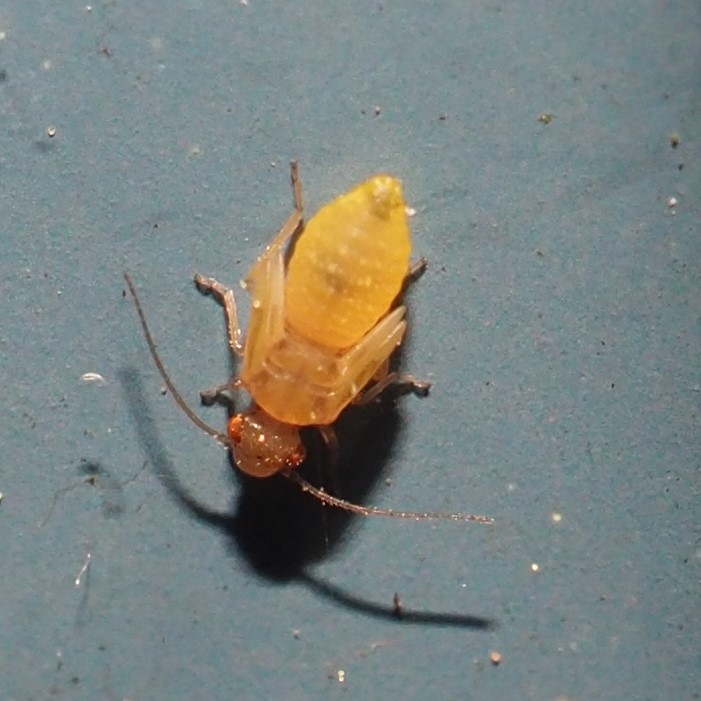
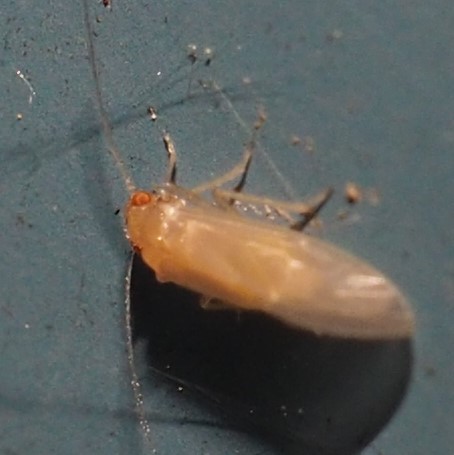
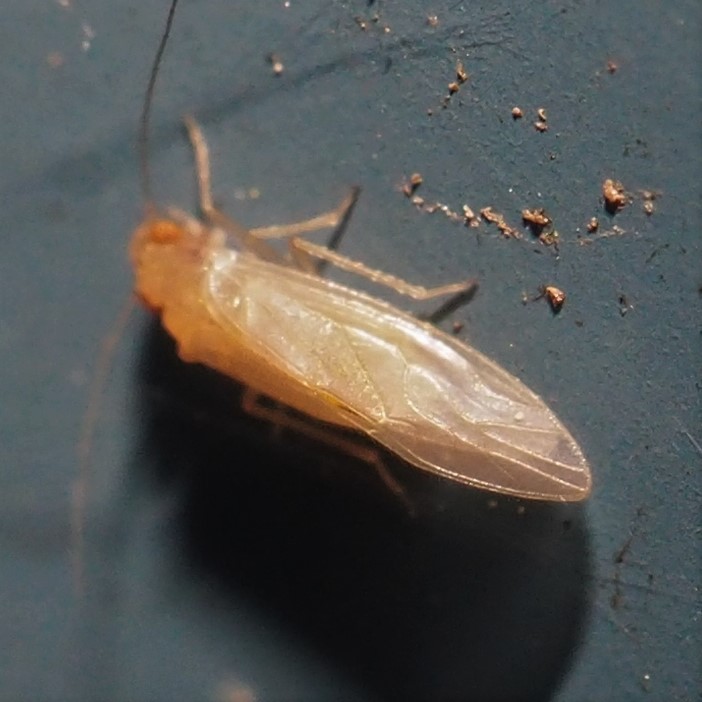
Other news of this morning, June 6. I believe we are down to the two former South Wall nymphs, who have settled down onto the South Wall. Sigh. Between the spiders and the rainfall on the North side, the once mildly burgeoning North Wall nursery had NO visible babies. So it is a race against time for these two and whoever is still out there. Note that one of the nymphs shed a skin during the night.
Oh, but we do have new news. On the East Side this morning, I found a healthy-looking clutch of eggs in one of the locations where the nymphs had been morphing into G. cruciatus adults.
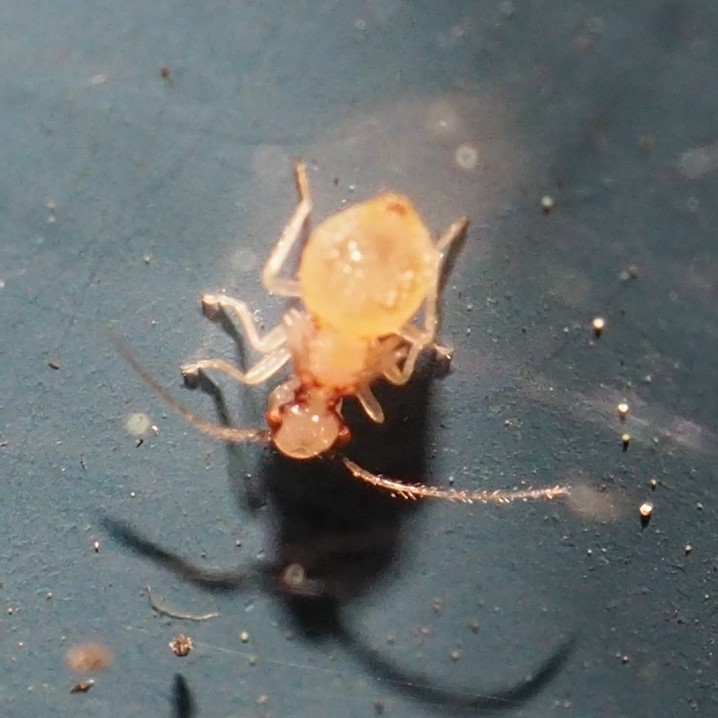
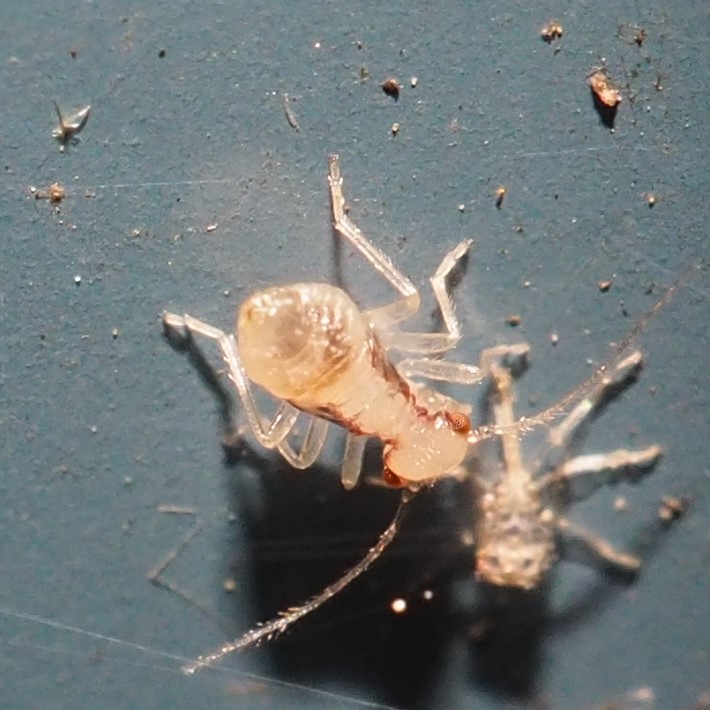
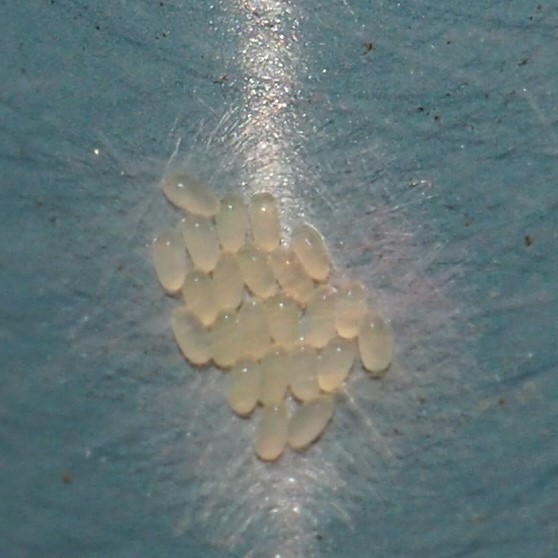
There has been a certain nymph that looks a lot like the G. cruciatus nymphs, but with a strange red mark on the head and a more rosy tone. Here it was on June 2, 3, and 4. I didn't see it again today but did find this lovely reddish adult. Note that the nymphs have dark eyes and a v-shaped insignia on their heads. So does the adult, nicknamed "Big Red".
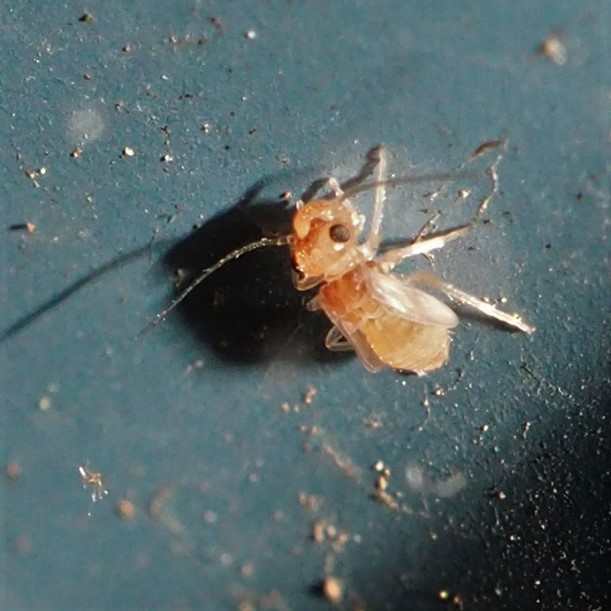
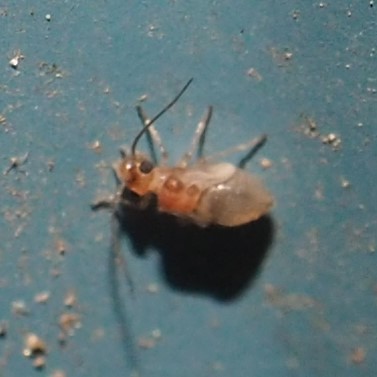
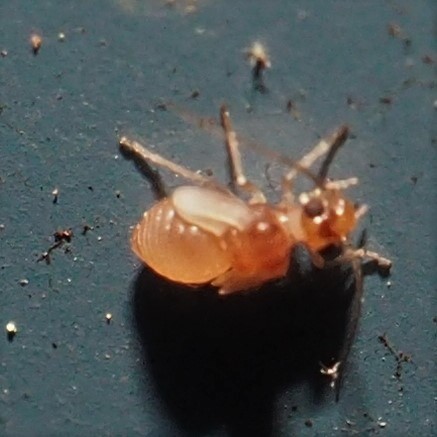
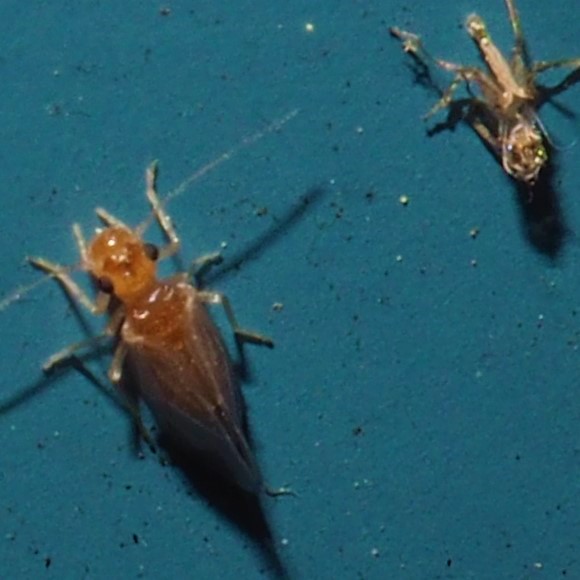
The day after the Reddish nymph became the Reddish adult, I didn't see Big Red anymore. But there were various other adults, and I'm wondering if any of them were the same as Red but just darkened. On June 7, there was a brownish one, an even darker (blackish) one, and a brownish-gold one. The brownish-gold one has reddish eyes and so I'm betting on its being a recently eclosed V. flavidus. The other two have dark eyes like Big Red, but don't seem to have preserved the "V" marking.
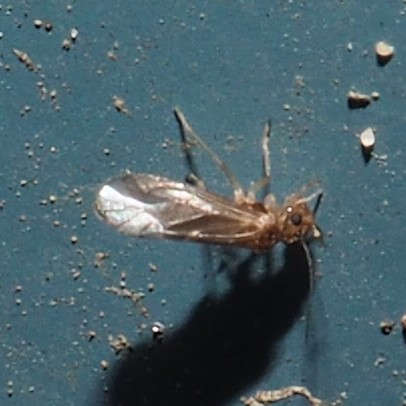
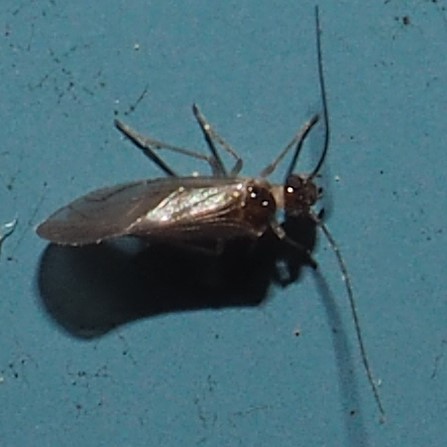
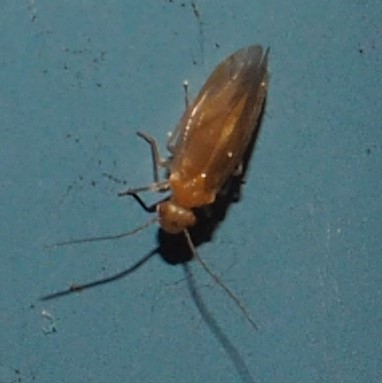
On June 8, I wrote: "Meanwhile we have gotten down, thanks to those tiny spiders and rain, down to two of the "North" nymphs, two on the North Wall and two on the South Wall. Here is one of the two South Wall nymphs - look how long its wings are - I think it will be morphing to adult SOON." Picture 1 shows the oneOn June 9, I discovered that if you want a picture of these nymphs, it would be a lot better not to scrape the chair too loudly or too close to a nymph, as they can now RUN FAST and disappear somewhere. This morning, I got out there early (about 8:30 am) and quietly and sat down at North Panel 1. To my shock, there were THREE nymphs in that panel (picture 2). Picture 3 (June 10)shows the two clearer nymphs.
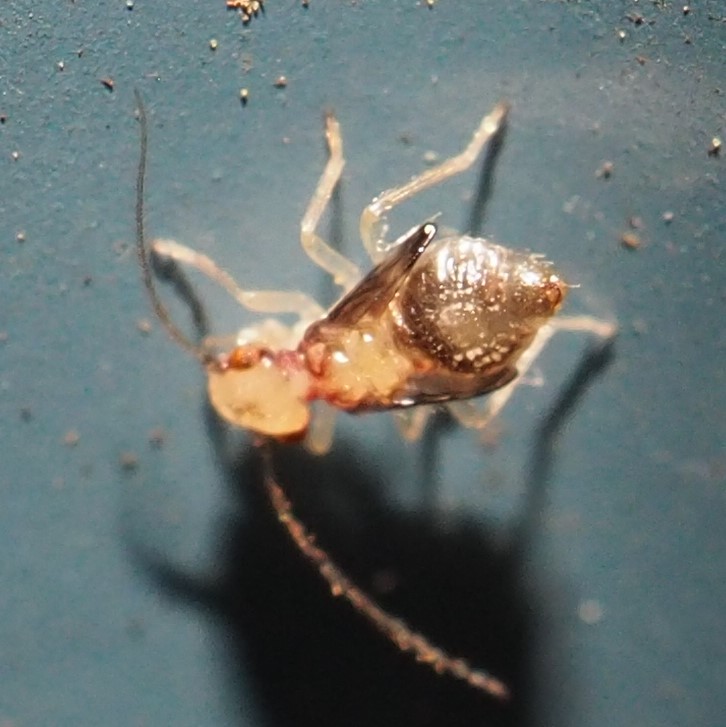
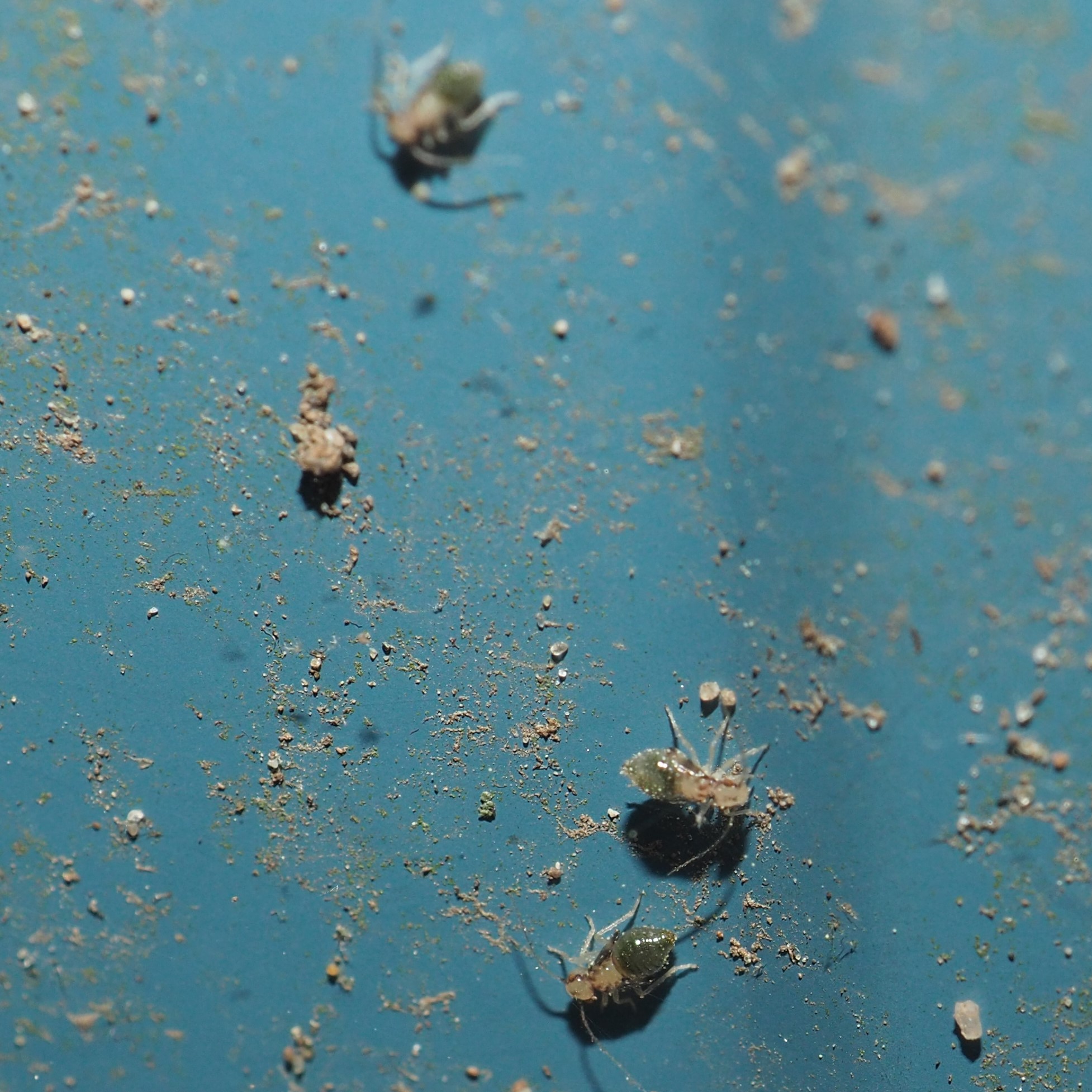
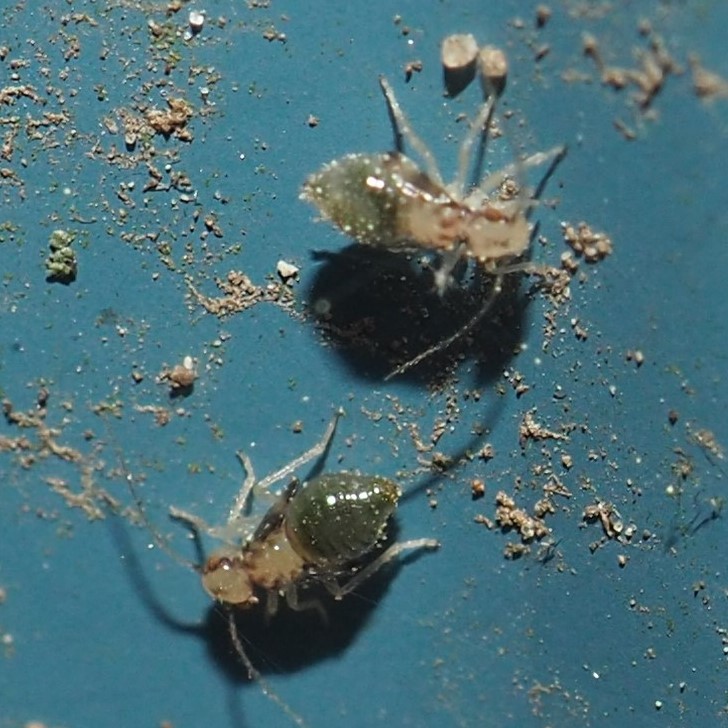
I quietly shifted the camera to look at panel 2. It also had THREE nymphs. When I cropped out the fuzzier one, I got this second image. Third: there was this one on panel 4. In all these images, the wings seem to be about the right length for some adult-morphing.
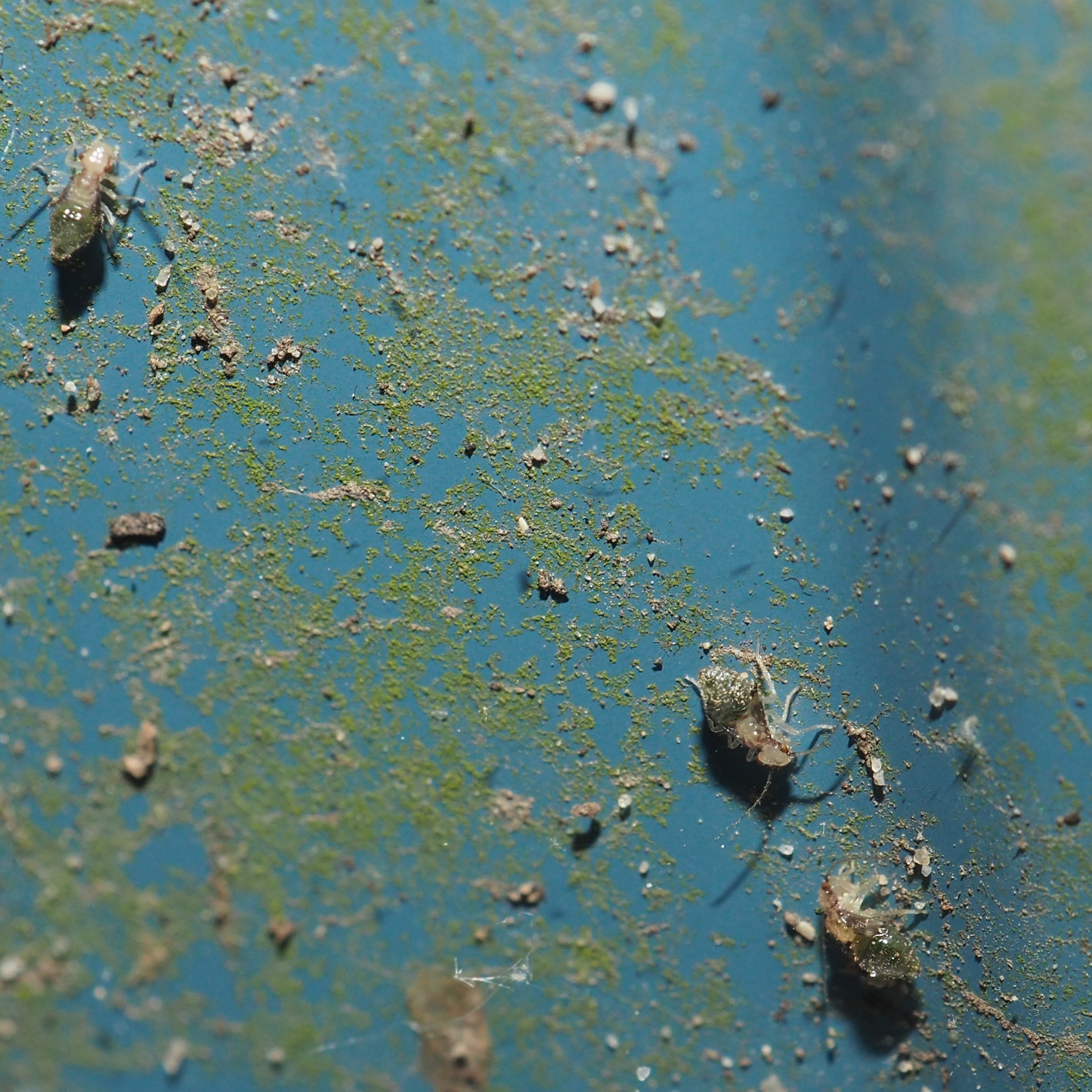
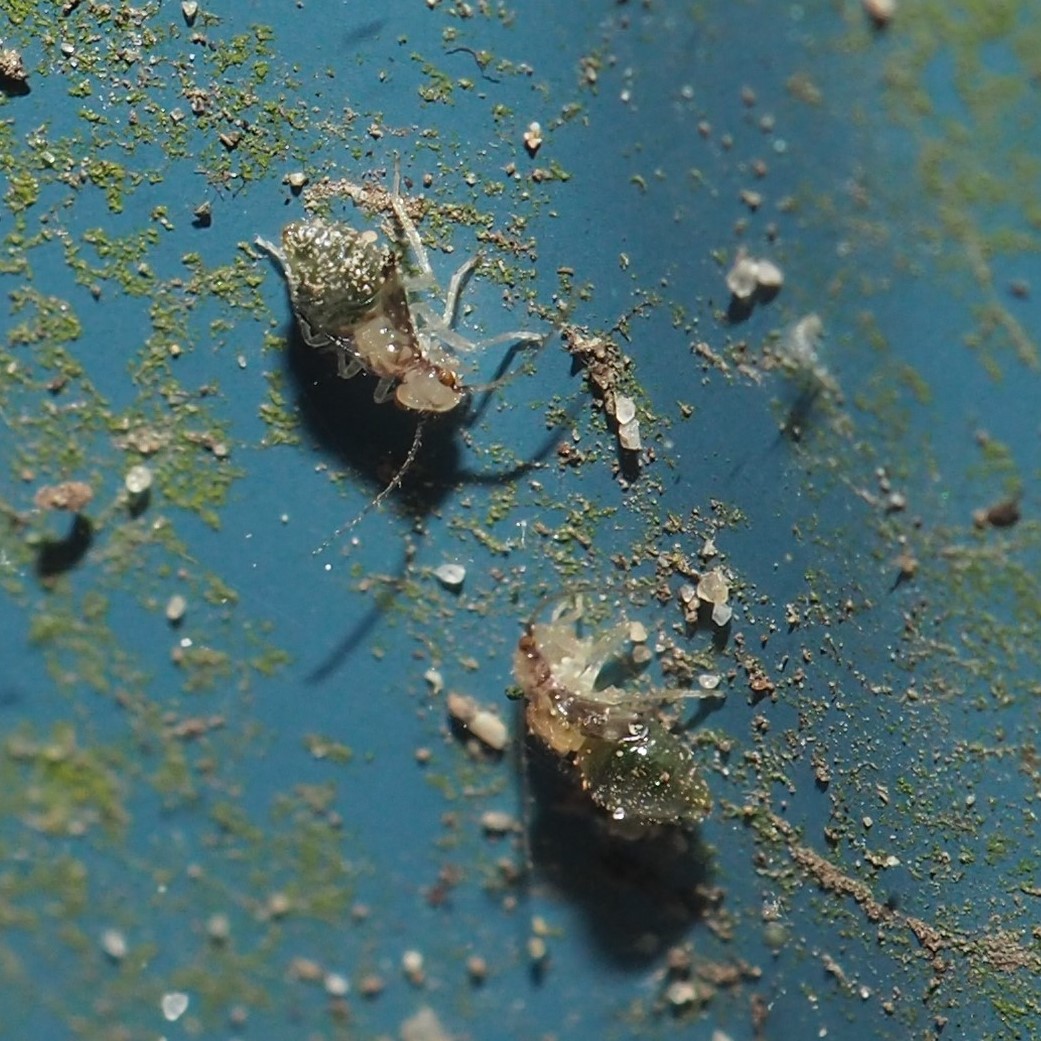
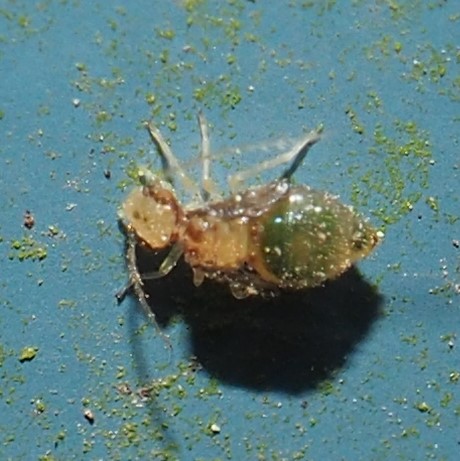
Next, I moved to the most southmost of the East Wall panels. When I got to panels 7 and 8, I found that each panel had at least one nymph. And one of those panels contained a nymph and one of what seemed to be a new adult! Picture 1 shows the two characters. Picture 2: the new adult. The still-nymph characters began to change from one panel to the other. Last: a better picture of the new adult taken after a few hours. One problem with assuming this is an adult form of the North Nymphs is that it doesn't seem to have the red eyes one would expect. But we still have a number of those nymphs that should be almost ready to mature to adults. I'm keeping my eyes open! (postscript to this whole thing : good thing we kept our minds open.)
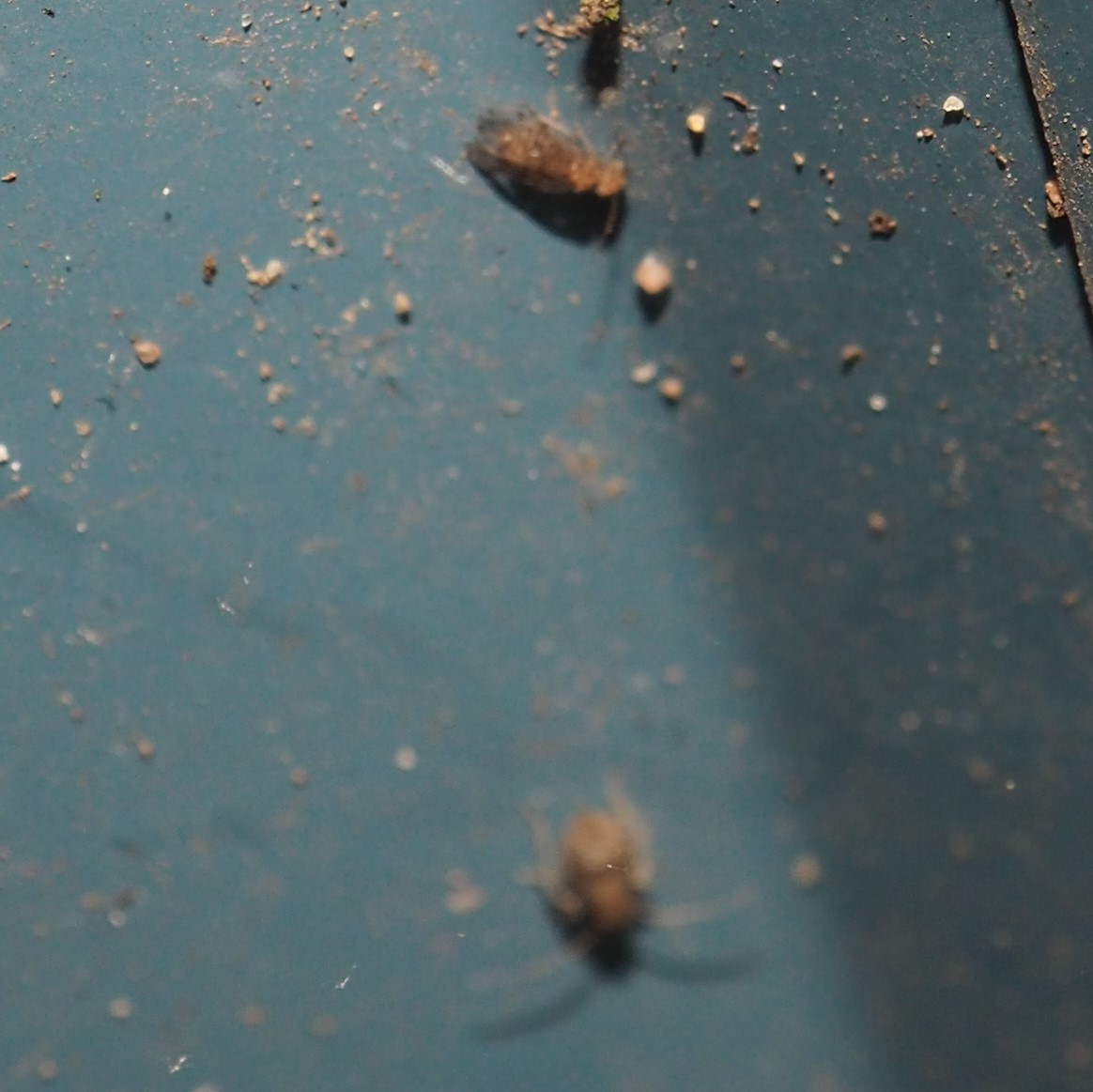
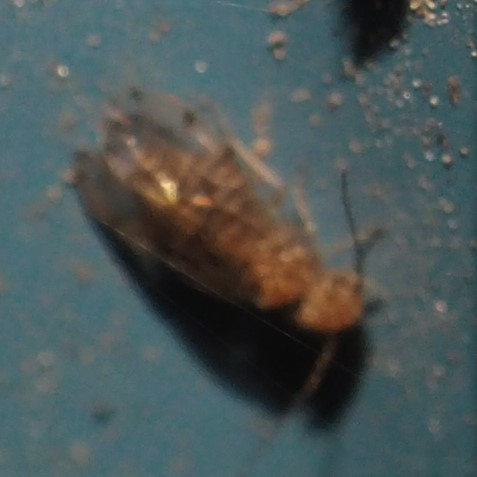
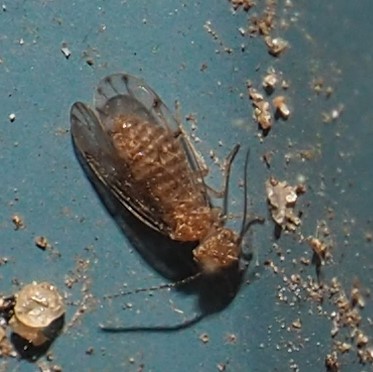
In moving from south to north along the East Wall, I passed a couple of landmarks. The clutch of eggs I had seen the other day had seemed to contain first 23 and then 19 eggs. Then to my horror, it was down to 8 eggs. Well, it turns out that there are actually THREE clutches of eggs on the East Wall: one containing 23 eggs, another containing 19, and another containing 8 eggs! Postscript to that. On the North wall, there are actually 3 MORE clutches. One on panel 9 from the left and two on panel 11 near the Air Conditioner.
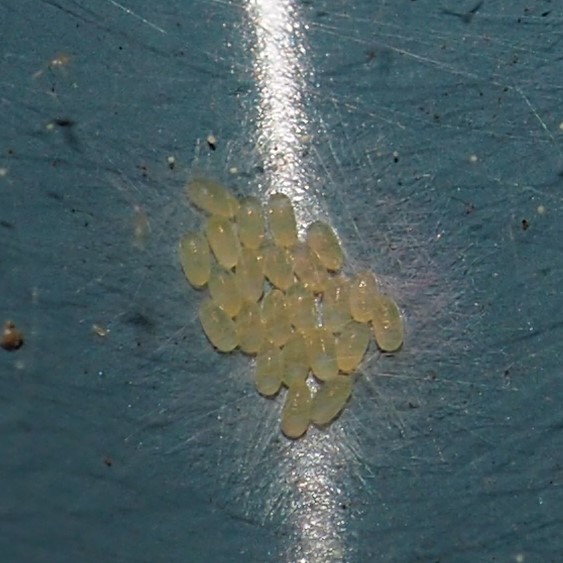
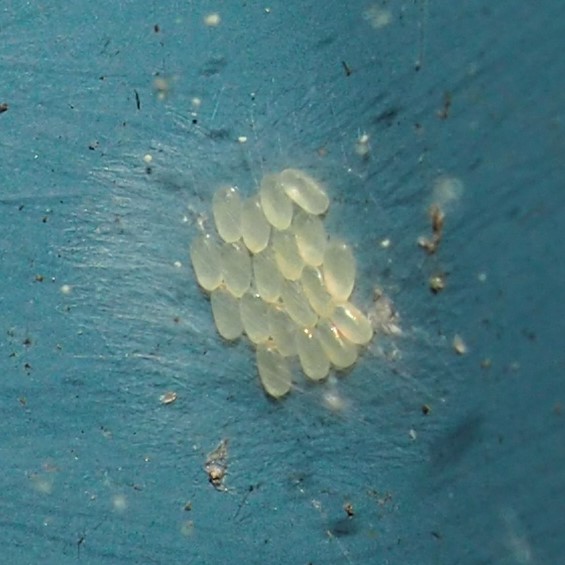
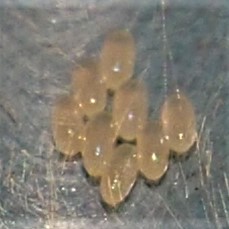
June 15. Gradually the little North Wall Nymphs have become fewer and fewer. The last couple of days I've seen one on the East Wall 3 panels from the Northern corner; one on panel 2, which seemed to amble off underneath the shop on June 13; and one right under the Air Conditioner seen on June 12 to wander up into the AC or nearly. The one that was left on the South Wall also ambled off under my gaze underneath the Shop.
Here is the one on North Panel 2 going under the Shop.
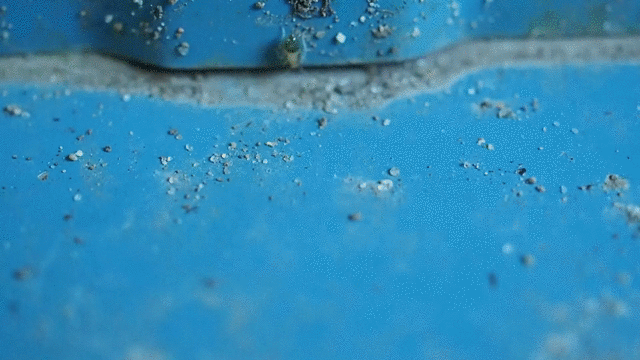
Here is (picture 1) the one 3 panels from the north on the East Wall and (picture 2) the one last seen under the AC.
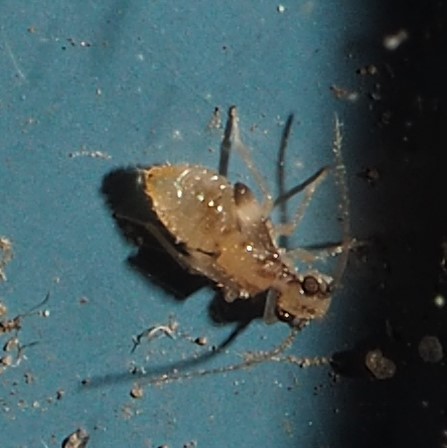
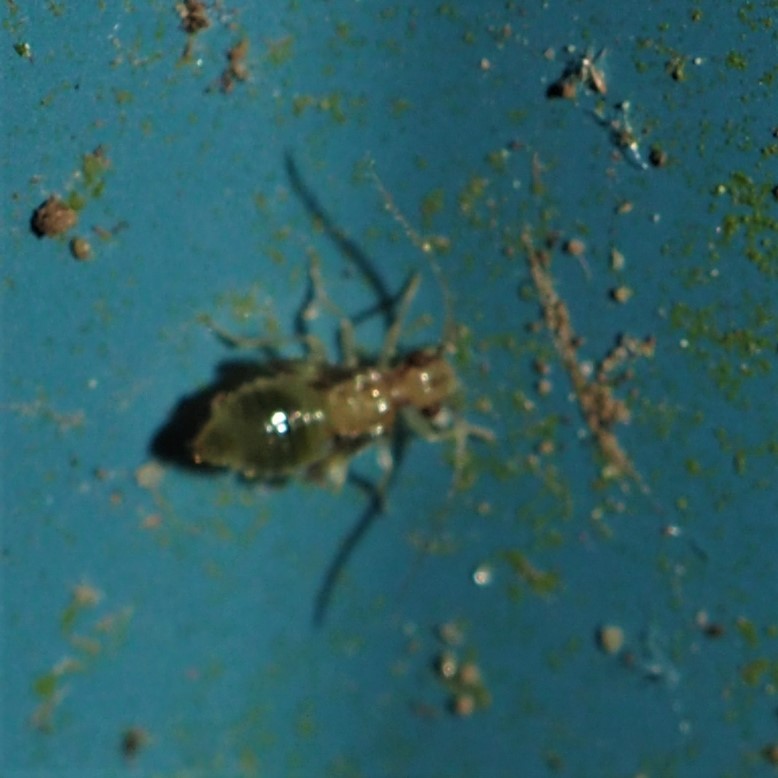
By the late afternoon of June 14, I couldn't find ANY of the nymphs. But on the morning of June 15, there were three new barklouse adults: one on the East Wall, third panel from north ; one on the South Wall; and the one on the North Wall under the Air Conditioner. These are Polypsocus corruptus.

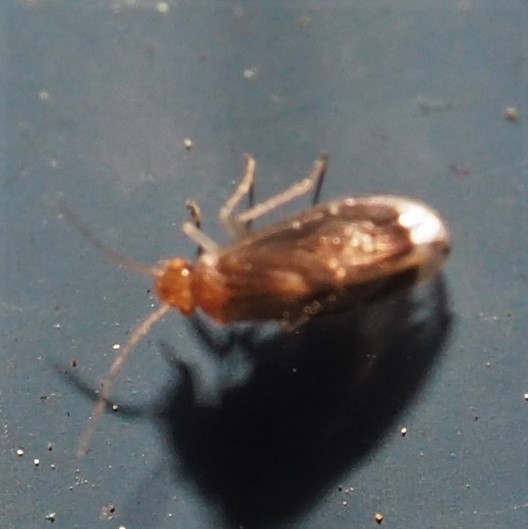
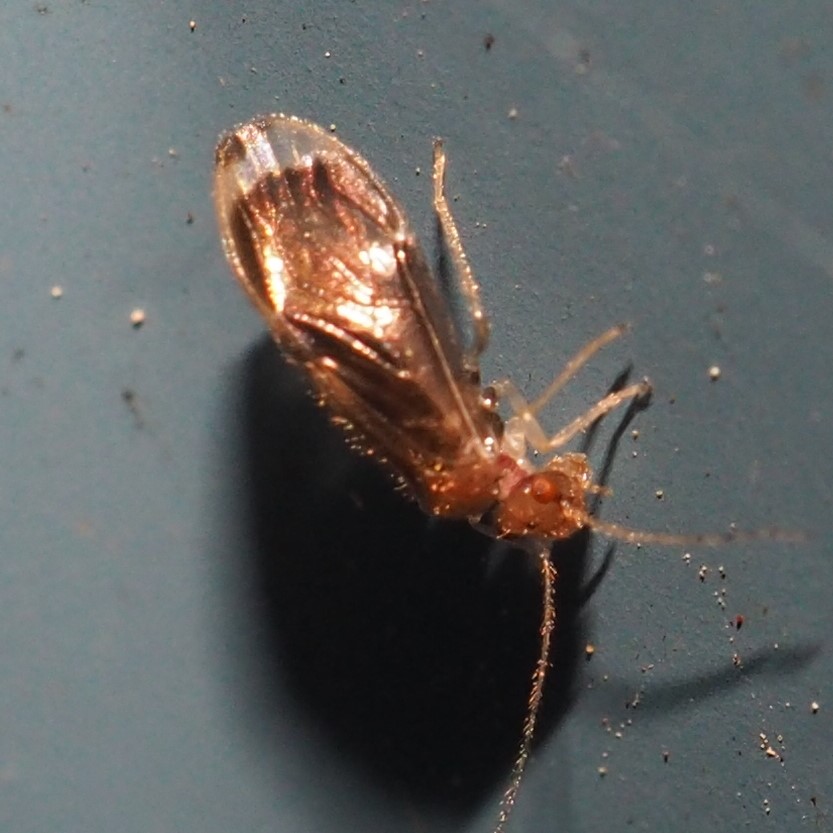
By the way, taken within seconds of picture 3 above is this creature which I'd labeled "new adult" - it turns out to be taken from a slightly different angle and that makes all the difference. I also have a shot from November 5, 2018, in which I'd also incorrectly labeled it different from the P. corruptus picture that was taken at virtually the same instant.
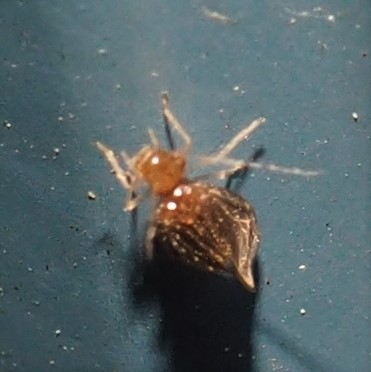
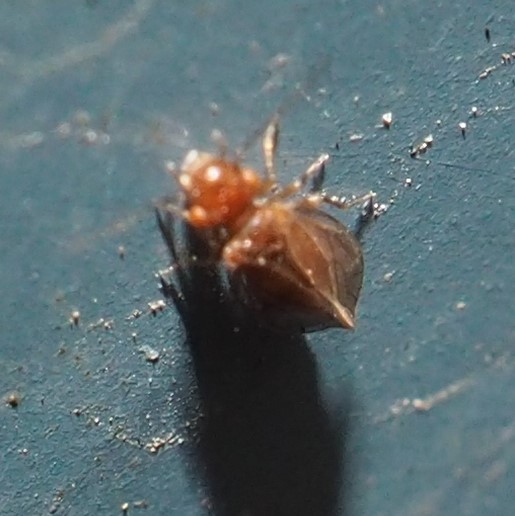
By the way, again,
I have a couple of old pictures of P. corruptus from 2019 and earlier. They aren't new to this year. I just never knew the relationship between our mysterious nymphs and P. corruptus before. This first picture is from a year ago, June 11, 2019, and shows a very fuzzy P. corruptus and a "nymph friend", which does look a bit like our babes. There is also a picture (picture 2) from September 23, 2019, that looks like our new nymphs. I think I labeled it P. corruptus because of Picture 1.
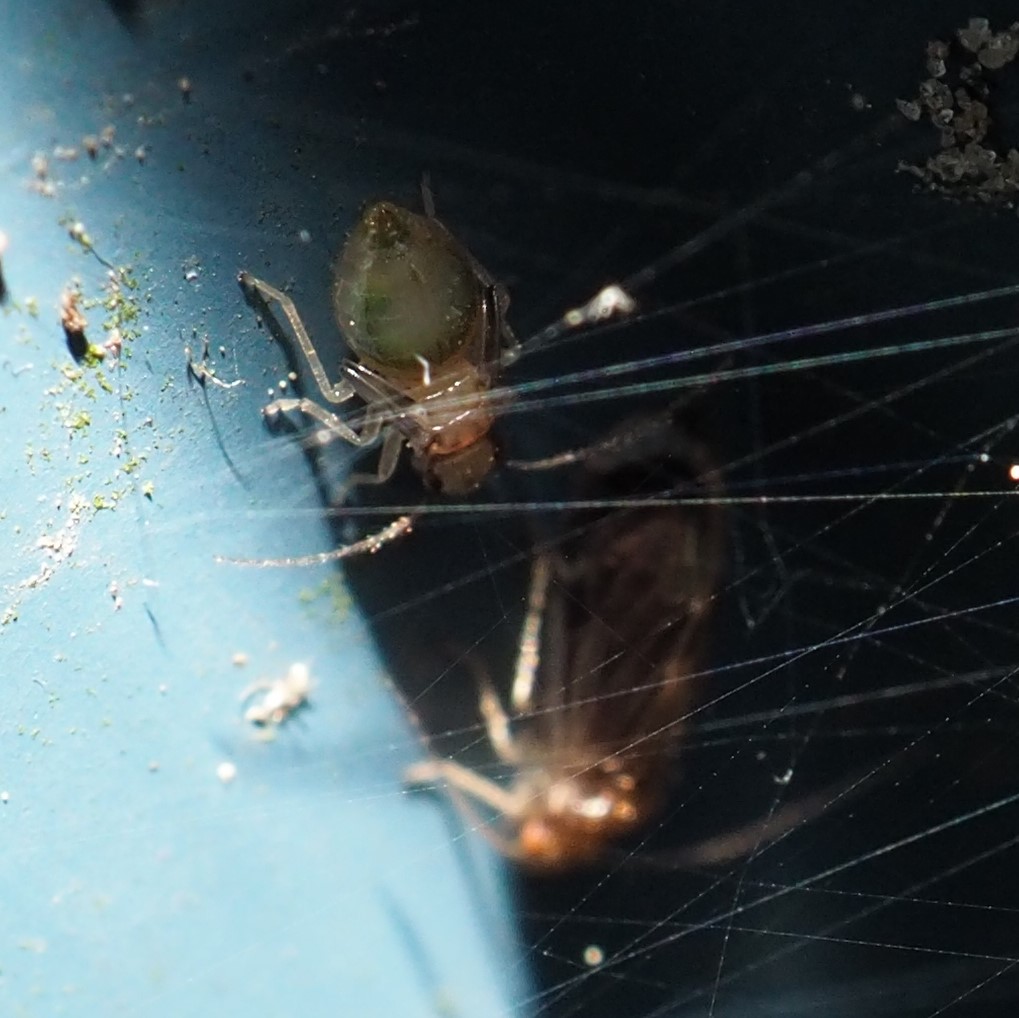
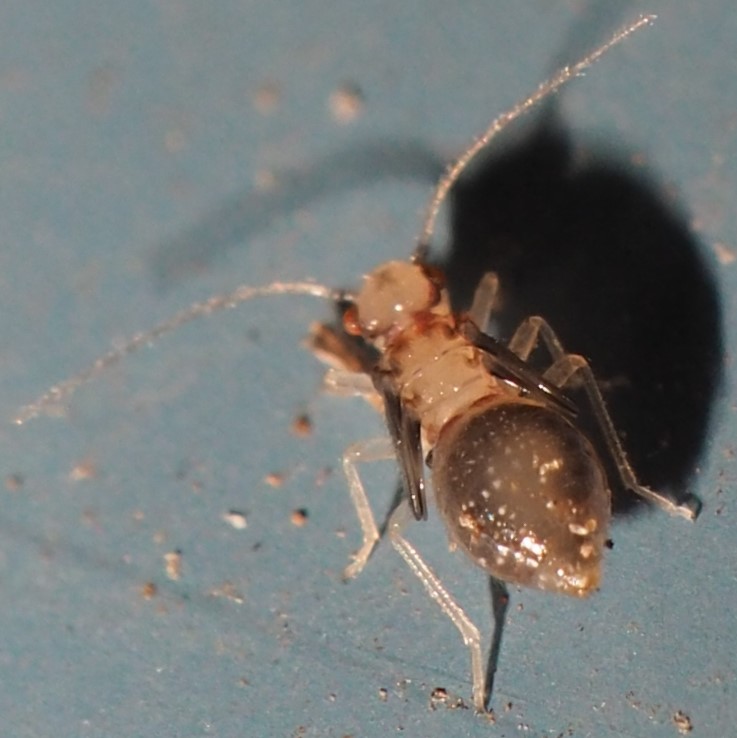
This summer, for a couple of months, from mid-August through September, I have been following what was to me a new species, namely Ectopsocus meridionalis. For this, see
this website.
September 21.
Something else I just noticed on September 21. Just in between panels 8 and 9 on the North Wall, there are some interesting new eggs. Maybe just because an Echmepteryx hageni nymph was sitting below the egg mass, I proposed to myself that maybe these are actually E. hageni eggs. The next day, September 22, the nymph was gone but the eggs are still there.
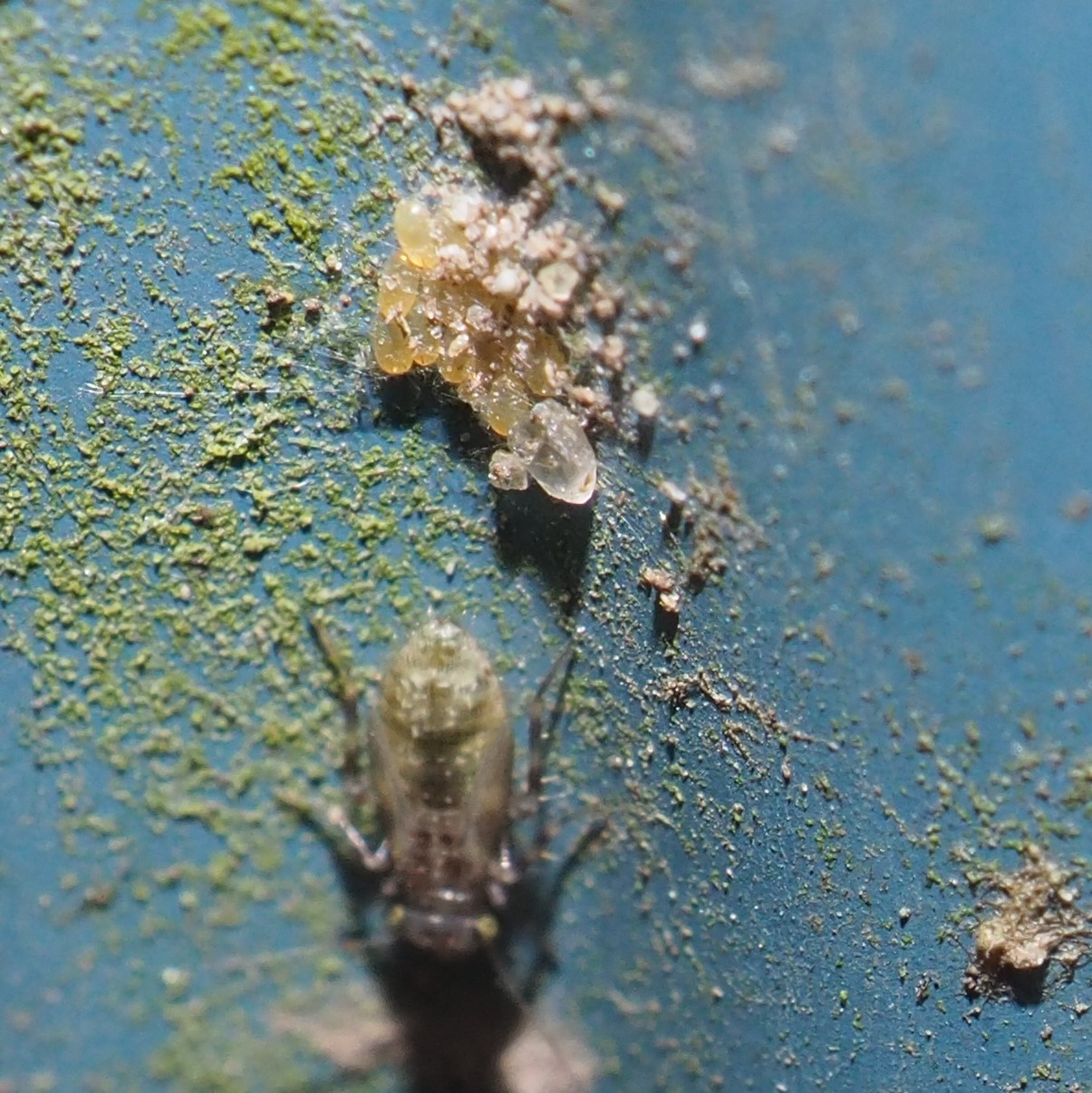
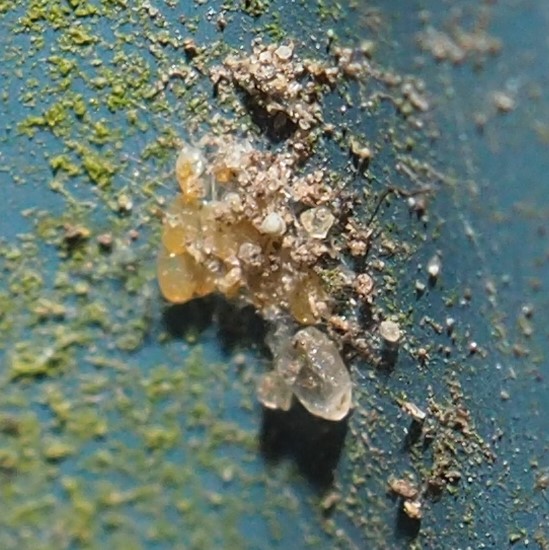
The next day, September 23, the eggs had begun hatching when I went out. Here they are at 10:41 am and 11:31 am.
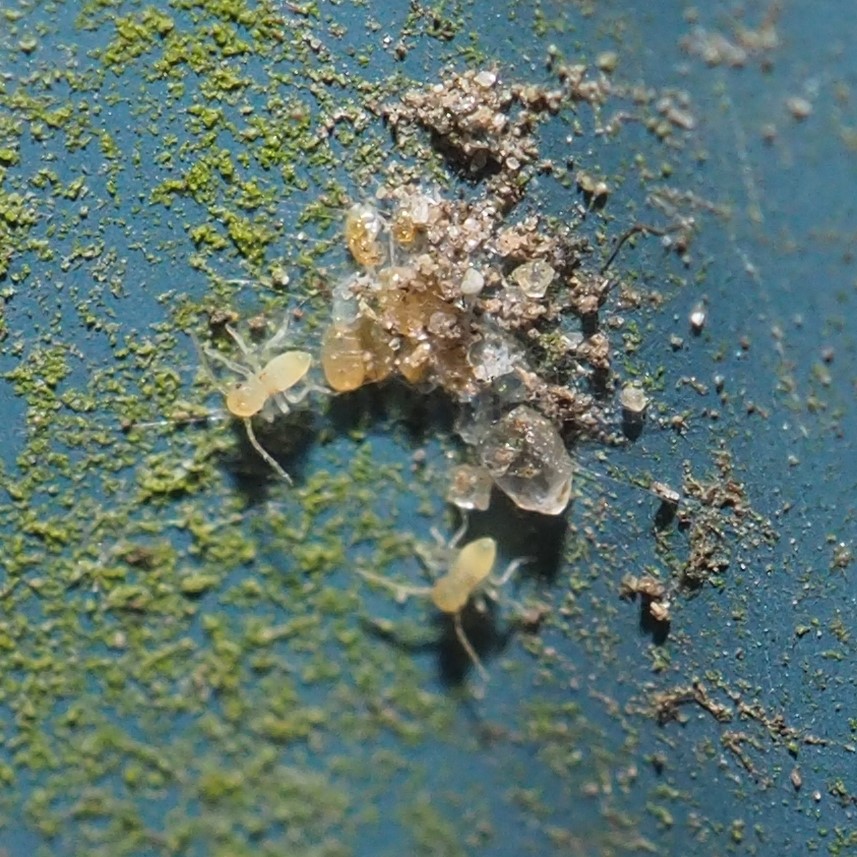
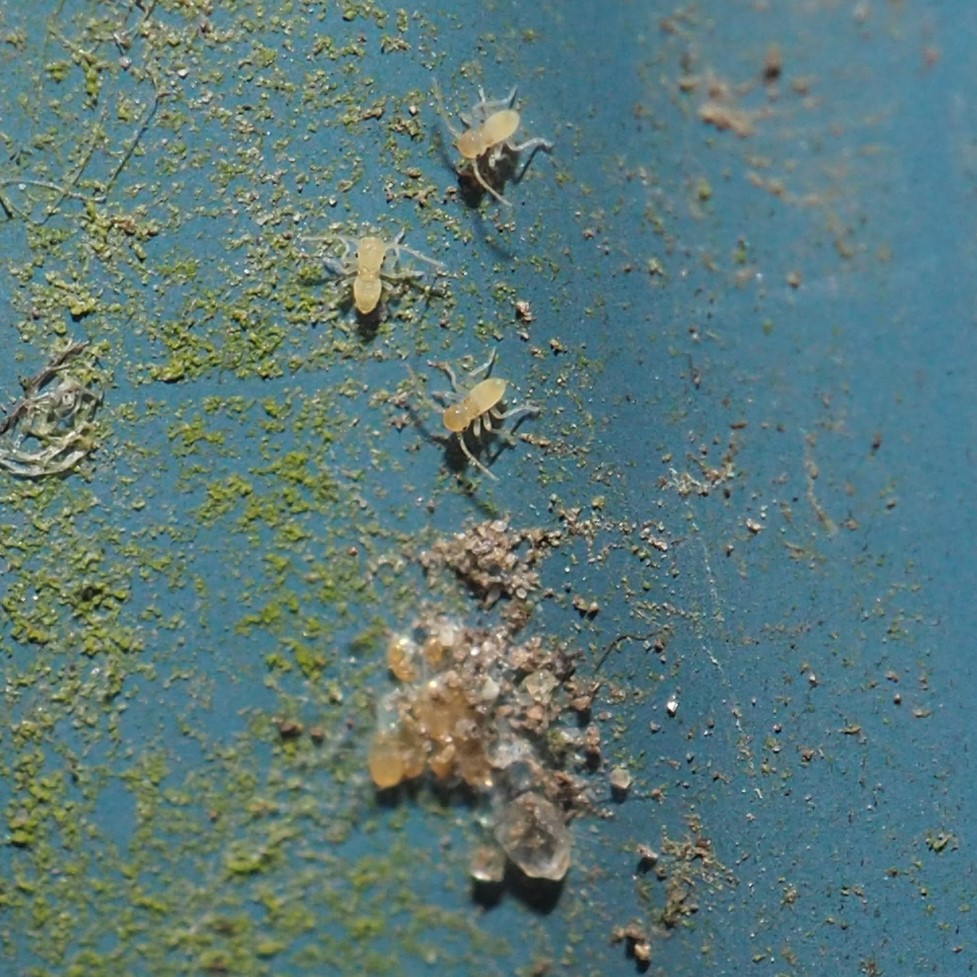
Still on September 23, at 1:07 pm, 5:14 pm, and 6:02 pm.
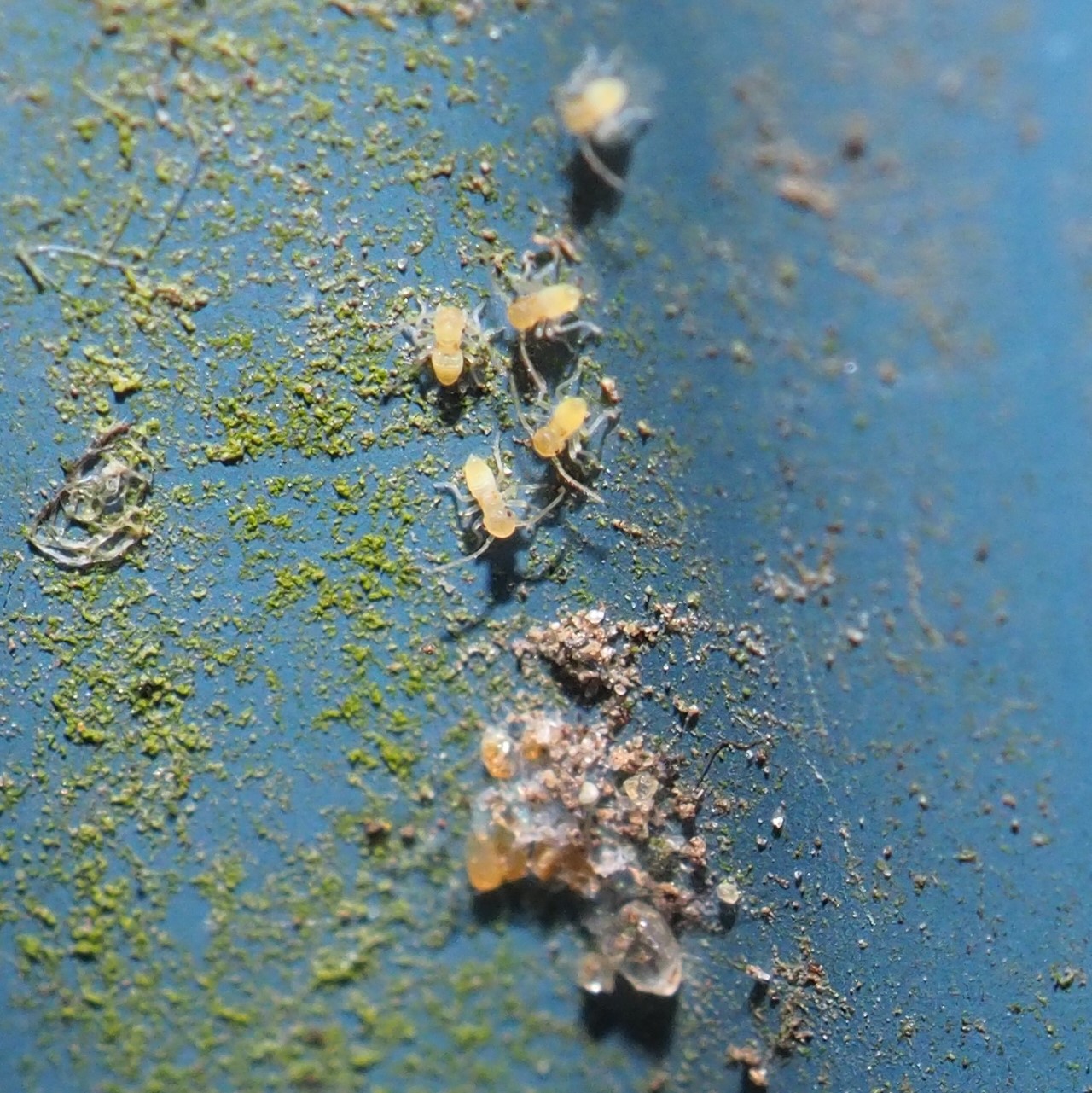
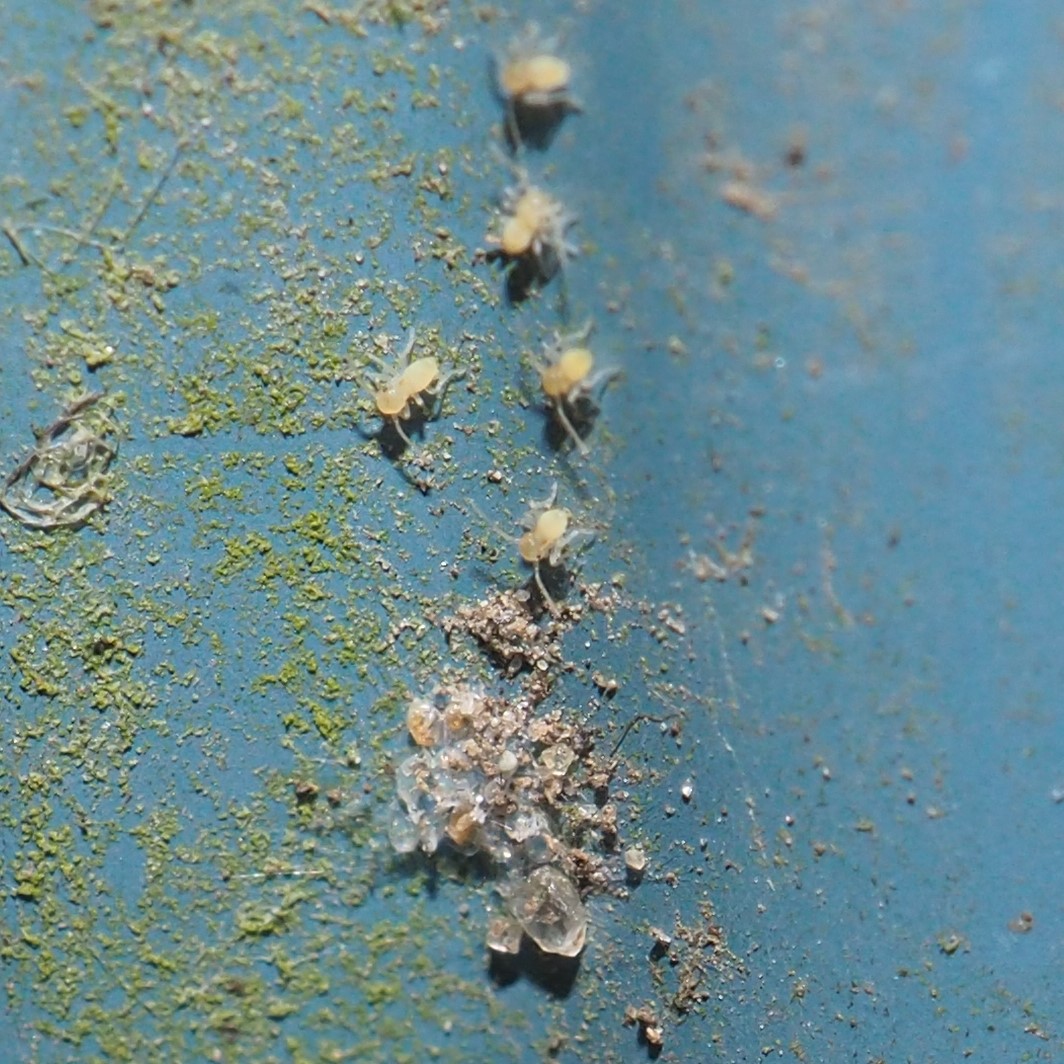
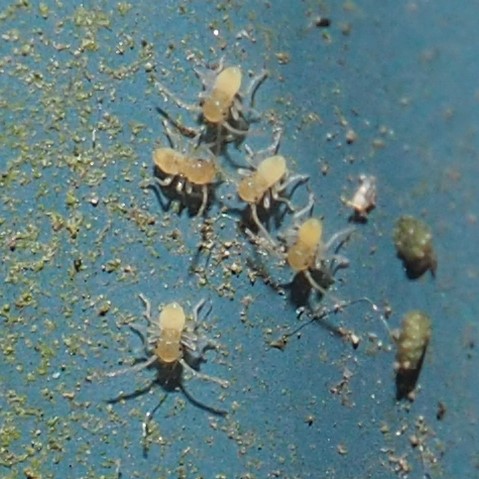
One of the little nymphs moving about on its first day of hatched life.
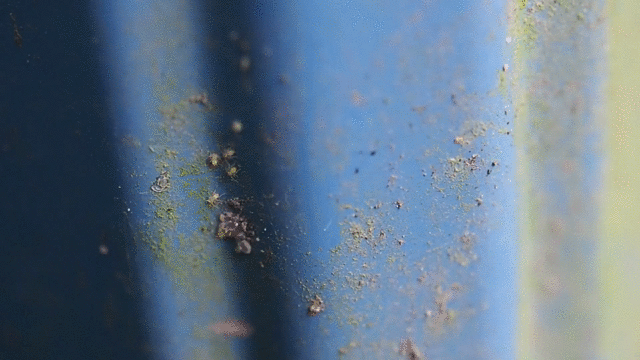
On the 24th at 10:24 and at 3:54, and a closeup that shows the nymphs beginning to look like Graphopsocus cruciatus nymphs. I think the difference in the location and condition of the egg mass had fooled me.
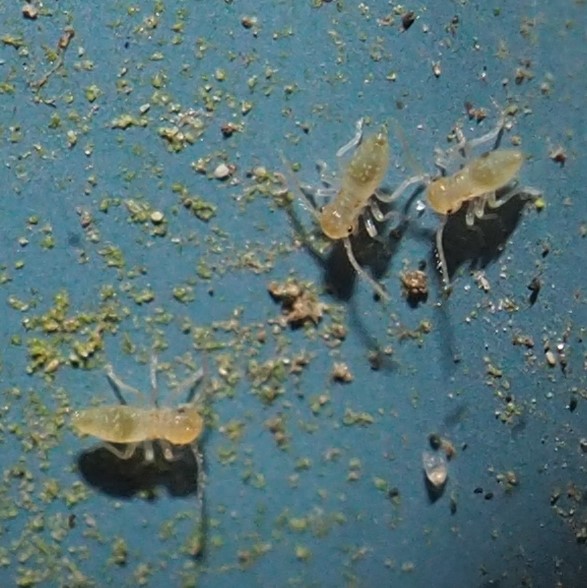
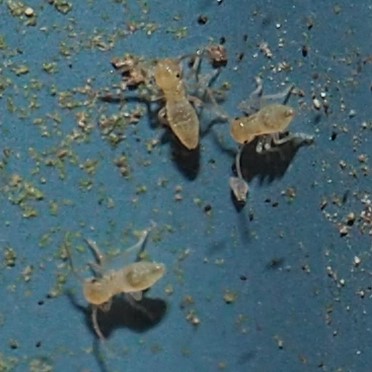
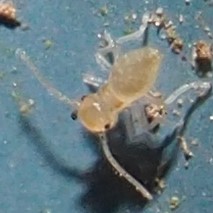
But wait. Here are some from September 27, four days old. They still don't seem to have the G. cruciatus spots. In our blog for October 11, 2020 we see that the dots appear within a few hours of birth of a nymph. So I still believe these bugs are NOT G. cruciatus. However, they have effectively disappeared, so their identity is still OUT.
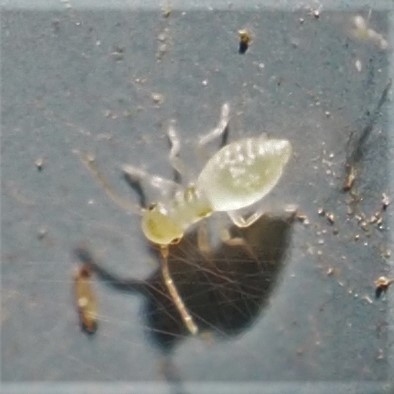
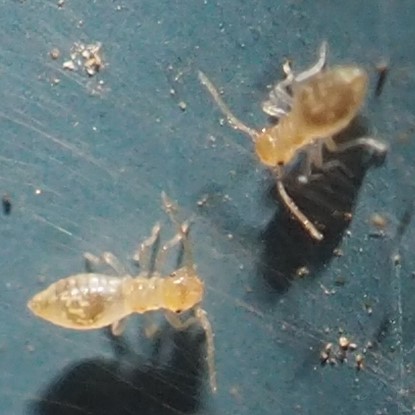
Copyright Martha O'Kennon 2020 




























































































































